Paul van Yperen's Blog, page 84
June 13, 2023
Leontine Kühnberg
Leontine Kühnberg (1889-1945?) was a German theatre and silent film actress. For a time she belonged to the ensemble of Max Reinhardt's Deutsches Theater. Shortly before the outbreak of the First World War, she began to make films. In 1921 she married and withdrew from the film sets. She was Jewish and probably died at the end of WW II.
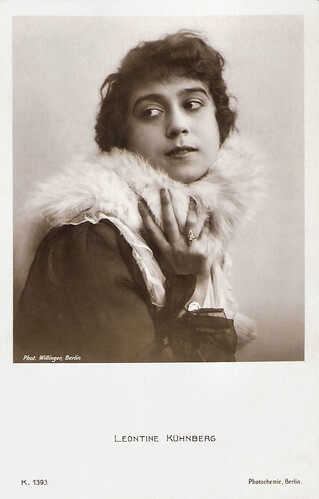
German postcard by Photochemie, Berlin, no. K. 1393. Photo: Willinger, Berlin.

German postcard by Photochemie, Berlin, no. K. 2637. Photo: Eichberg-Film. The film title Uns aber ist gegeben auf keiner Stätte zu ruhen/But to us it is given to rest on no place is absent on IMDb and Filmportal . From the six films that Richard Eichberg directed with Leontine Kühnberg in 1918, all for his own company Eichberg-Film, a probable option is Im Zeichen der Schuld/Under the sign of guilt (Richard Eichberg, 1918), aka Aus dem Leben eines Vorbestraften/From the life of a convicted man. Filmportal.de lists this as the only film in which Bruno Decarli and Kühnberg played together in a film by Eichberg-Film. The plot deals with a man (Decarli) who, convicted of forging his boss's name, kills the bank director and assumes his identity. However, the Early German Film Database does list the film Uns aber ist gegeben, auf keiner Stätte zu ruhen as a separate film (1918), directed by Eichberg, and starring Decarli and Kühnberg. So perhaps, this is a separate film after all.
An impossible menage à trois
Leontine Kühnberg was born Leontine Chimberg in 1889 in Berlin. She was the daughter of the Jewish merchant Emil Chimberg and his wife Heni, née Lastu. Leontine can be traced as a theatre actress from 1908. For a time she belonged to the ensemble of Max Reinhardt's Deutsches Theater.
Shortly before the outbreak of the First World War, she began to make films, first under the direction of Harry Piel in Der schwarze Pierrot/The Black Pierrot (1913) with Ludwig Trautmann . In 1914 she started at PAGU / Union, led by Paul Davidson. Her participation in two Hermann Sudermann adaptations, Die Geschichte der stillen Mühle/The story of the silent mill (Richard Oswald, 1914) and Der Katzensteg/The catwalk (Max Mack, 1915), brought her recognition.
The former film dealt with an impossible menage à trois, also with Alfred Abel and Robert Valberg, while the latter was set in Napoleonic times and dealt first with a father-son conflict in which a maiden was forced to help the father and the French enemy, and later on the son, despite being a Prussian free fighter, defending the woman at all costs. Ferdinand Bonn , who later on often acted with her, already had supporting parts in these two films.
Kühnberg continued at PAGU in films such as Pension Lampel (Max Mack, 1915) and So rächt sich die Sonne/This is how the sun takes revenge (William Wauer, 1915) based on a script by Richard Oswald. Apart from PAGU she also acted in the mid-1910s in Otto Rippert's Der grüne Mann von Amsterdam/The green man from Amsterdam (1916) with Erich Kaiser-Titz , Harry Piel 's Das lebende Rätsel/The living enigma (1915) with Ludwig Trautmann .
She also acted in Richard Oswald's films Seine letzte Maske/His last mask (1916), Zirkusblut/Circus blood (1916), Des Goldes Fluch/The Curse of Gold (1917), and in particular, in the lost film Es werde Licht/Let There Be Light, I (1917), protesting the anti-abortion-law and warning against syphilis. In all these films she co-starred with Bernd Aldor . According to IMDb , Kühnberg also acted in two Hungarian films: Az ezüst kecske/The Medic (Michael Curtiz, 1916) with Victor Varconi, and A Világ csak hangulat/The World is just a mood (Eugen Illés, 1917). With Eugen Illés she also would do various German films too.
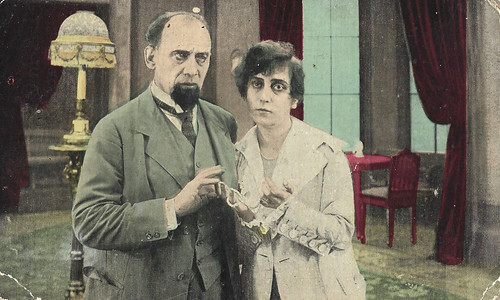
Spanish collector's card (cromo) by Chocolat Imperial, no. 1 of 6. Photo: Distr. J. Verdaguer, Barcelona / Eichberg-Film. Leontine Kühnberg and Ferdinand Bonn in Die goldene Mumie/The Golden Mummy (Richard Eichberg, 1918).
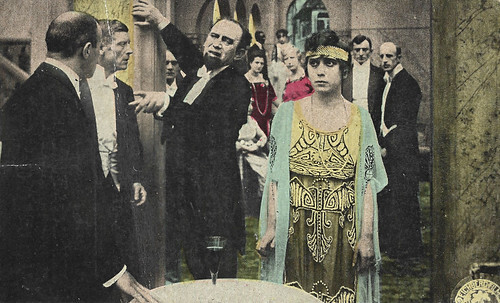
Spanish collector's card (cromo) by Chocolat Imperial, no. 3 of 6. Photo: Distr. J. Verdaguer, Barcelona / Eichberg-Film. Leontine Kühnberg and Ferdinand Bonn in Die goldene Mumie (Richard Eichberg, 1918).
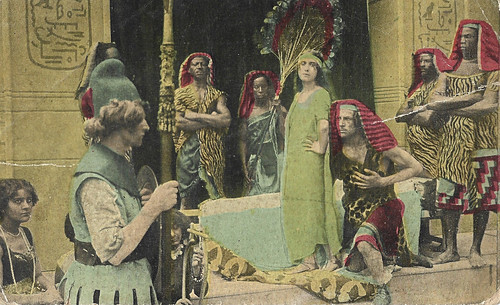
Spanish collector's card (cromo) by Chocolat Imperial, no. 4 of 6. Photo: Distr. J. Verdaguer, Barcelona / Eichberg-Film. Leontine Kühnberg and Ferdinand Bonn in Die goldene Mumie (Richard Eichberg, 1918).
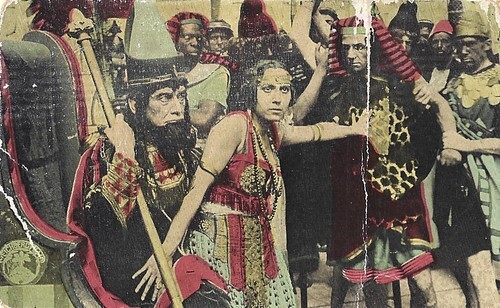
Spanish collector's card (cromo) by Chocolat Imperial, no. 5 of 6. Photo: Distr. J. Verdaguer, Barcelona / Eichberg-Film. Leontine Kühnberg and Ferdinand Bonn in Die goldene Mumie (Richard Eichberg, 1918).
A Daughter of Her People
In 1918, after a few films at Duskes and Neutral-Film, Leontine Kühnberg stepped over to Eichberg-Film, where she did seven films from 1918-1919 under the direction of Richard Eichberg. These included Die goldene Mumie/The Golden Mummy (1918), also with Ferdinand Bonn , Die letzte Liebesnacht der Inge Tolmein/Inge Tolmein's Last Night of Love (1918), with Karl Falkenberg, and Die Tragödie der Manja Orsan/The Tragedy of Manja Orsan (1919), in which she had the title role opposite Charles Willy Kaiser .
She then moved to Neutral-Film for a few films under the direction of Eugen Illés, e.g. Die silberne Fessel/The silver shackle (1919-20) and Moral (1920), often acting opposite Ernst Rückert .
Her last films were for the company Neos-Film, among which Judith Trachtenberg (Henrik Galeen, 1920), about a young Jewish woman who cannot choose between her Jewish family and roots and her non-Jewish lover, a count (Paul Otto). Moreover, she is pregnant with her husband-to-be. In the end, she commits suicide. In 1932 an American remake was released as A Daughter of Her People. According to IMDb , the film was re-edited and re-released with a new framing story as A Daughter of Her People (Henrik Galeen, George Roland, 1932)
At the beginning of 1921, Leontine Kühberg got married to the businessman and film producer Ludwig Schwarz in Vienna, for whose Neos-Film GmbH she had appeared in leading roles three times before. She withdrew from the film sets. In the following years, the couple lived in the Berlin districts of Wilmersdorf and Charlottenburg, where Ludwig Schwarz ran a large hosiery factory. In 1930, Leontine Kühnberg was the owner of the short-lived publishing house Buchkultur, which she ran together with her husband.
No definite information is currently available about her later fate. In 1970, Leontine Kühnberg was declared dead at the Schöneberg District Court, with 31 December 1945 as the official date of death. Her last place of residence was presumably Warsaw so it must be assumed that the actress, who was considered a "full Jewess" according to Nazi racial doctrine, died violently - possibly in connection with the Warsaw Ghetto. Her husband had already been declared dead in 1962. IMDb writes she already died in 1924 but this is a mistake. The writer Ernst Birnbaum was a cousin of Leontine Kühnberg.

German postcard by Verlag Hermann Leiser, Berlin-Wilm., no. 3165. Photo: Becker & Maass, Berlin.
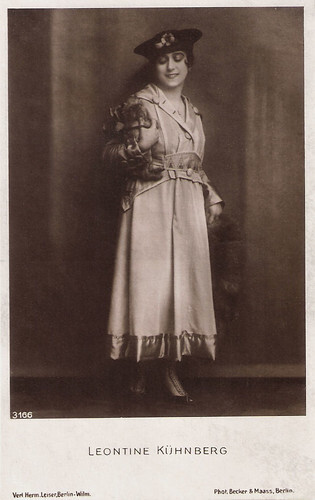
German postcard by Verlag Hermann Leiser, Berlin-Wilm., no. 3166. Photo: Becker & Maass, Berlin.
Sources: Filmportal, Wikipedia (German) and .

German postcard by Photochemie, Berlin, no. K. 1393. Photo: Willinger, Berlin.

German postcard by Photochemie, Berlin, no. K. 2637. Photo: Eichberg-Film. The film title Uns aber ist gegeben auf keiner Stätte zu ruhen/But to us it is given to rest on no place is absent on IMDb and Filmportal . From the six films that Richard Eichberg directed with Leontine Kühnberg in 1918, all for his own company Eichberg-Film, a probable option is Im Zeichen der Schuld/Under the sign of guilt (Richard Eichberg, 1918), aka Aus dem Leben eines Vorbestraften/From the life of a convicted man. Filmportal.de lists this as the only film in which Bruno Decarli and Kühnberg played together in a film by Eichberg-Film. The plot deals with a man (Decarli) who, convicted of forging his boss's name, kills the bank director and assumes his identity. However, the Early German Film Database does list the film Uns aber ist gegeben, auf keiner Stätte zu ruhen as a separate film (1918), directed by Eichberg, and starring Decarli and Kühnberg. So perhaps, this is a separate film after all.
An impossible menage à trois
Leontine Kühnberg was born Leontine Chimberg in 1889 in Berlin. She was the daughter of the Jewish merchant Emil Chimberg and his wife Heni, née Lastu. Leontine can be traced as a theatre actress from 1908. For a time she belonged to the ensemble of Max Reinhardt's Deutsches Theater.
Shortly before the outbreak of the First World War, she began to make films, first under the direction of Harry Piel in Der schwarze Pierrot/The Black Pierrot (1913) with Ludwig Trautmann . In 1914 she started at PAGU / Union, led by Paul Davidson. Her participation in two Hermann Sudermann adaptations, Die Geschichte der stillen Mühle/The story of the silent mill (Richard Oswald, 1914) and Der Katzensteg/The catwalk (Max Mack, 1915), brought her recognition.
The former film dealt with an impossible menage à trois, also with Alfred Abel and Robert Valberg, while the latter was set in Napoleonic times and dealt first with a father-son conflict in which a maiden was forced to help the father and the French enemy, and later on the son, despite being a Prussian free fighter, defending the woman at all costs. Ferdinand Bonn , who later on often acted with her, already had supporting parts in these two films.
Kühnberg continued at PAGU in films such as Pension Lampel (Max Mack, 1915) and So rächt sich die Sonne/This is how the sun takes revenge (William Wauer, 1915) based on a script by Richard Oswald. Apart from PAGU she also acted in the mid-1910s in Otto Rippert's Der grüne Mann von Amsterdam/The green man from Amsterdam (1916) with Erich Kaiser-Titz , Harry Piel 's Das lebende Rätsel/The living enigma (1915) with Ludwig Trautmann .
She also acted in Richard Oswald's films Seine letzte Maske/His last mask (1916), Zirkusblut/Circus blood (1916), Des Goldes Fluch/The Curse of Gold (1917), and in particular, in the lost film Es werde Licht/Let There Be Light, I (1917), protesting the anti-abortion-law and warning against syphilis. In all these films she co-starred with Bernd Aldor . According to IMDb , Kühnberg also acted in two Hungarian films: Az ezüst kecske/The Medic (Michael Curtiz, 1916) with Victor Varconi, and A Világ csak hangulat/The World is just a mood (Eugen Illés, 1917). With Eugen Illés she also would do various German films too.

Spanish collector's card (cromo) by Chocolat Imperial, no. 1 of 6. Photo: Distr. J. Verdaguer, Barcelona / Eichberg-Film. Leontine Kühnberg and Ferdinand Bonn in Die goldene Mumie/The Golden Mummy (Richard Eichberg, 1918).

Spanish collector's card (cromo) by Chocolat Imperial, no. 3 of 6. Photo: Distr. J. Verdaguer, Barcelona / Eichberg-Film. Leontine Kühnberg and Ferdinand Bonn in Die goldene Mumie (Richard Eichberg, 1918).

Spanish collector's card (cromo) by Chocolat Imperial, no. 4 of 6. Photo: Distr. J. Verdaguer, Barcelona / Eichberg-Film. Leontine Kühnberg and Ferdinand Bonn in Die goldene Mumie (Richard Eichberg, 1918).

Spanish collector's card (cromo) by Chocolat Imperial, no. 5 of 6. Photo: Distr. J. Verdaguer, Barcelona / Eichberg-Film. Leontine Kühnberg and Ferdinand Bonn in Die goldene Mumie (Richard Eichberg, 1918).
A Daughter of Her People
In 1918, after a few films at Duskes and Neutral-Film, Leontine Kühnberg stepped over to Eichberg-Film, where she did seven films from 1918-1919 under the direction of Richard Eichberg. These included Die goldene Mumie/The Golden Mummy (1918), also with Ferdinand Bonn , Die letzte Liebesnacht der Inge Tolmein/Inge Tolmein's Last Night of Love (1918), with Karl Falkenberg, and Die Tragödie der Manja Orsan/The Tragedy of Manja Orsan (1919), in which she had the title role opposite Charles Willy Kaiser .
She then moved to Neutral-Film for a few films under the direction of Eugen Illés, e.g. Die silberne Fessel/The silver shackle (1919-20) and Moral (1920), often acting opposite Ernst Rückert .
Her last films were for the company Neos-Film, among which Judith Trachtenberg (Henrik Galeen, 1920), about a young Jewish woman who cannot choose between her Jewish family and roots and her non-Jewish lover, a count (Paul Otto). Moreover, she is pregnant with her husband-to-be. In the end, she commits suicide. In 1932 an American remake was released as A Daughter of Her People. According to IMDb , the film was re-edited and re-released with a new framing story as A Daughter of Her People (Henrik Galeen, George Roland, 1932)
At the beginning of 1921, Leontine Kühberg got married to the businessman and film producer Ludwig Schwarz in Vienna, for whose Neos-Film GmbH she had appeared in leading roles three times before. She withdrew from the film sets. In the following years, the couple lived in the Berlin districts of Wilmersdorf and Charlottenburg, where Ludwig Schwarz ran a large hosiery factory. In 1930, Leontine Kühnberg was the owner of the short-lived publishing house Buchkultur, which she ran together with her husband.
No definite information is currently available about her later fate. In 1970, Leontine Kühnberg was declared dead at the Schöneberg District Court, with 31 December 1945 as the official date of death. Her last place of residence was presumably Warsaw so it must be assumed that the actress, who was considered a "full Jewess" according to Nazi racial doctrine, died violently - possibly in connection with the Warsaw Ghetto. Her husband had already been declared dead in 1962. IMDb writes she already died in 1924 but this is a mistake. The writer Ernst Birnbaum was a cousin of Leontine Kühnberg.

German postcard by Verlag Hermann Leiser, Berlin-Wilm., no. 3165. Photo: Becker & Maass, Berlin.

German postcard by Verlag Hermann Leiser, Berlin-Wilm., no. 3166. Photo: Becker & Maass, Berlin.
Sources: Filmportal, Wikipedia (German) and .
Published on June 13, 2023 22:00
June 12, 2023
Yvonne De Carlo
Dark-haired Hollywood beauty Yvonne De Carlo (1922–2007) was a Canadian American actress, singer, and dancer whose career in film, television, and musical theatre spanned six decades. From the 1950s on, she also starred in British and Italian films. She achieved her greatest popularity as the ghoulish matriarch Lily in the TV sitcom The Munsters (1964-1966).
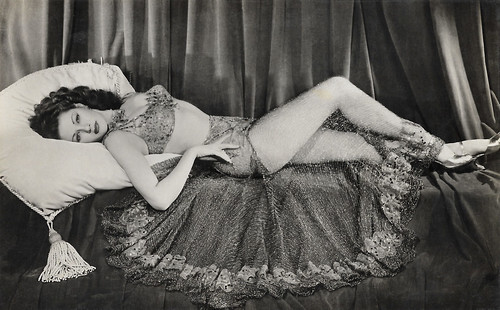
Spanish postcard in the Hollywood (California) series. Photo: Universal. Publicity still for Salome Where She Danced (Charles Lamont, 1945).
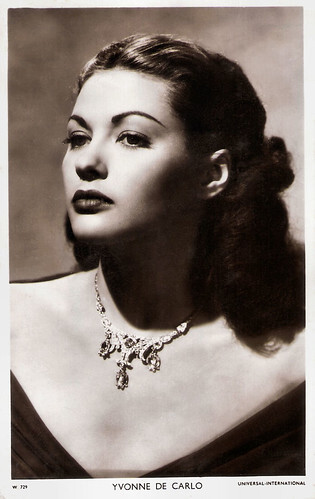
British postcard in the Picturegoer Series, London, no. W 729. Photo: Universal-International.
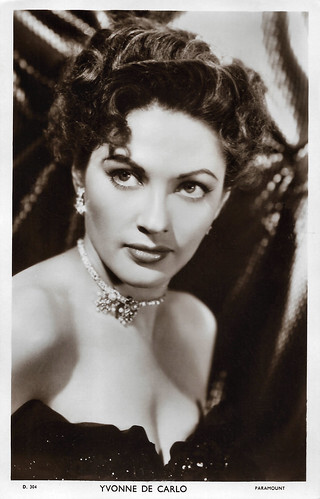
British postcard in the Picturegoer Series, London, no. D 304. Photo: Paramount.
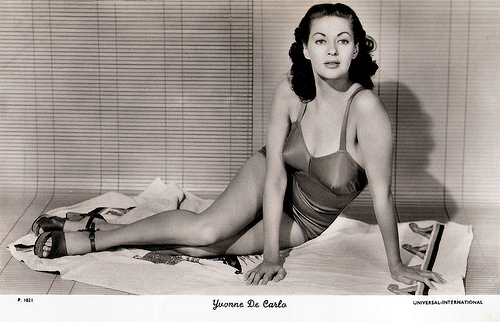
British postcard in The People series by Show Parade Picture Service, London, no. P. 1021. Photo: Universal-International.
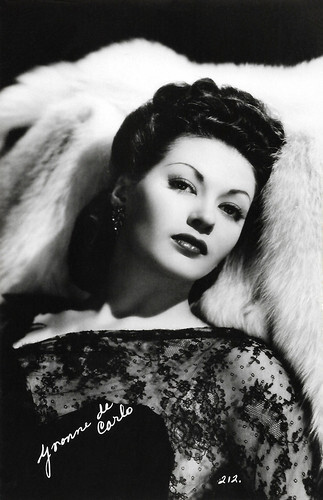
American photo postcard, no. 212.
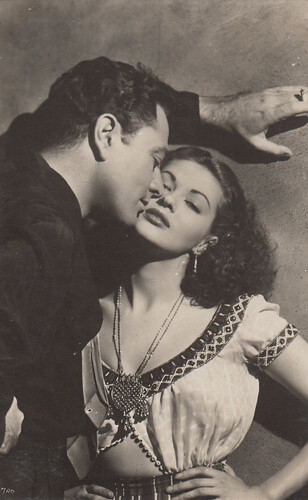
Spanish postcard, no. 4200. Yvonne De Carlo and Tony Martin in Casbah (John Berry, 1948). Collection: Marlene Pilaete.
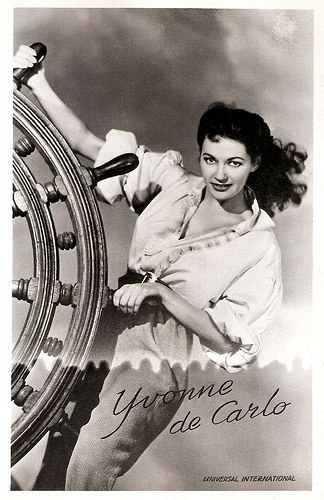
Dutch postcard by Takken, no. AX 144. Photo: Universal International. Publicity still for Buccaneer's Girl (Frederick De Cordova, 1950).
The most beautiful girl in the world
Yvonne De Carlo was born Margaret Yvonne Middleton in 1922 in West Point Grey (now part of Vancouver), British Columbia, Canada. She was the only child of William Middleton, an Australian-born salesman, and Marie DeCarlo, a French-born aspiring actress. Her father deserted the home, leaving her mother to make a living as a waitress. When De Carlo was ten her mother enrolled her in a local dance school and also saw that she studied dramatics. De Carlo and her mother travelled to Los Angeles to seek fame and fortune in Hollywood.
In 1940, she was first runner-up to Miss Venice Beach, and she also came fifth in the 1940s Miss California competition. A year later, she landed a bit part as a bathing beauty in Harvard, Here I Come (Lew Landers, 1941). She also appeared in the three-minute Soundies musical, The Lamp of Memory (1942), shown in coin-operated movie jukeboxes. Other roles were slow to follow, and De Carlo took a job in the chorus line of Earl Carroll. During World War II she performed for U.S. servicemen and received many letters from GIs.
She got her big break when she was chosen over a reported 20,000 girls to play the lead role as a European seductress in the Technicolor spectacle Salome, Where She Danced (Charles Lamont, 1945), with Rod Cameron and Walter Slezak . She played a dancer during the Austrian-Prussian war who is forced to flee her country after she is accused of being a spy and ends up in a lawless Western town in Arizona. Producer Walter Wanger described her as "the most beautiful girl in the world." Though not a critical success, it was a box-office favourite, and the heavily-promoted De Carlo was hailed as an up-and-coming star. Universal signed her to a long-term contract.
De Carlo was given a small role in the prison film Brute Force (Jules Dassin, 1947), starring Burt Lancaster . Two years later she was again cast opposite Lancaster in her first important role in the classic Film Noir Criss Cross (Robert Siodmak, 1949). Claudio Carvalho at IMDb : " Burt Lancaster has an outstanding performance in the role of an honest man obsessed with his former wife, who becomes a criminal trying to regain the love of his fickle ex-wife. Yvonne De Carlo is also perfect and very beautiful, in the role of a cold and manipulative woman, being a perfect 'femme-fatale'."
However, Universal preferred to cast De Carlo in more conventional fare, such as Casbah (John Berry, 1948) a musical remake of the 1938 film Algiers, the adventure film River Lady (George Sherman, 1948), and Buccaneer's Girl (Frederick de Cordova, 1950). In the latter, she played a New Orleans singer who becomes involved with a Pirate Lord (Philip Friend).
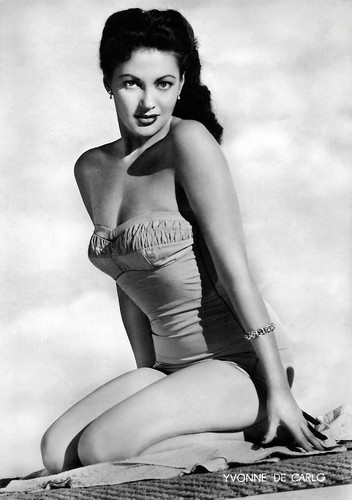
Italian postcard, no. 358.
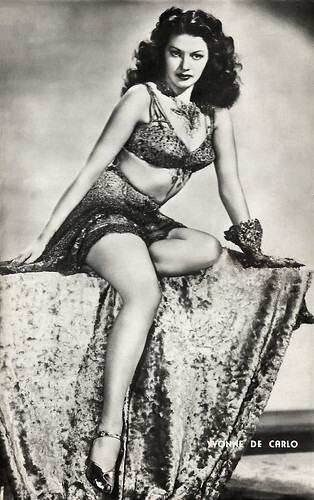
Vintage postcard. Photo: Universal. Publicity still for Salome Where She Danced (Charles Lamont, 1945).
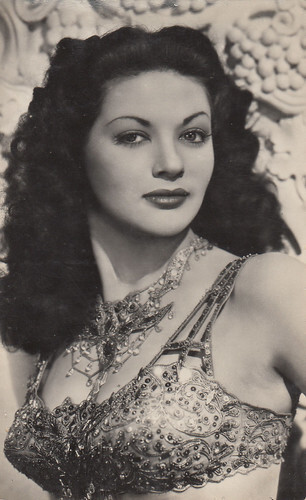
Spanish postcard by Archivo Bermejo, Barcelona, no. 3299. Photo: Universal. Yvonne De Carlo in Salome Where She Danced (Charles Lamont, 1945). Collection: Marlene Pilaete.
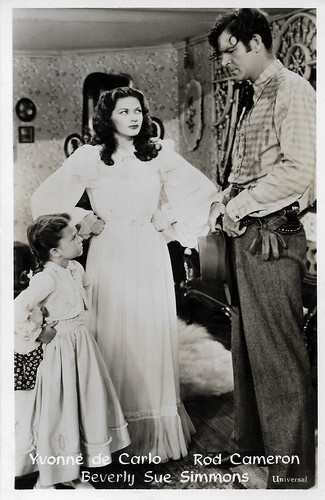
Belgian postcard by Nieuwe Merksemsche Chocolaterie S.P.R.I., Merksem (Anvers), no. C 24. Photo: Universal. Yvonne De Carlo, Rod Cameron and Beverly Sue Simmons in Frontier Gal (Charles Lamont, 1945).
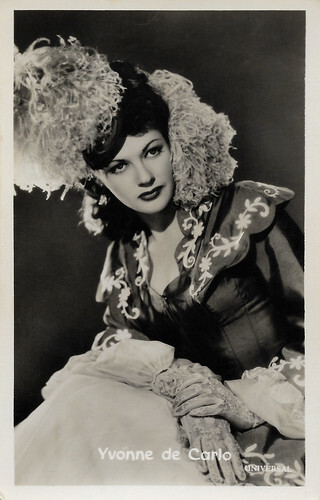
Belgian postcard by Nieuwe Merksemsche Chocolaterie S.P.R.I., Mersem (Anvers). Photo: Universal.
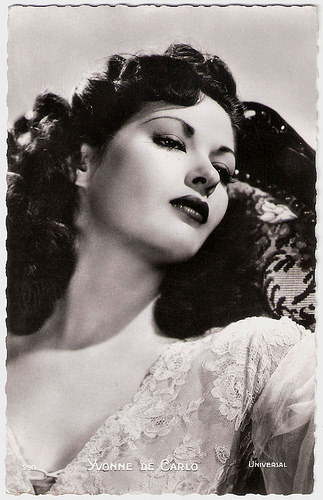
French postcard by Editions P.I., Paris, no. 298. Photo: Universal.
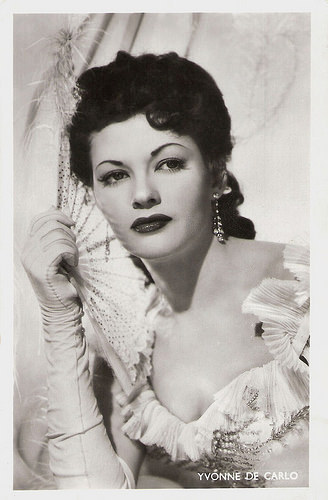
Dutch postcard by J. Sleding N.V., Amsterdam, no. 1250. Photo: Universal-International.
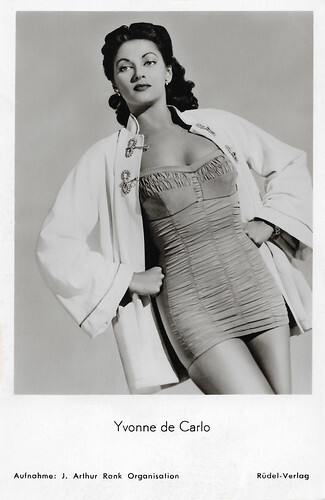
West-German postcard by Rüdel-Verlag, Hamburg-Bergedorf, no. 542. Photo: J. Arthur Rank Organisation. Yvonne de Carlo in Hotel Sahara (Ken Annakin, 1951).
Lily Munster
When Yvonne De Carlo was in England making Hotel Sahara (Ken Annakin, 1951), she asked Universal to release her contract even though she still had three months to go. The studio agreed. De Carlo had always travelled extensively to promote her films and her appearances were widely publicised. In 1951 she became the first American star to visit Israel. De Carlo regularly played in European films from now on. She starred in the British comedy The Captain's Paradise (Anthony Kimmins, 1953), about a captain of a ferry boat between the restricted British colony in Gibraltar and Spanish Morocco ( Alec Guinness ) who keeps two wives in separate ports. De Carlo of course played the hot-blooded mistress, Nita in Tangiers. She persuaded director Anthony Kimmins to talk Alec Guinness into doing the mambo with her in a nightclub sequence. Guinness, not usually thought of as a physical actor, consented to a week's worth of dance lessons from De Carlo and the sequence is one of the film's highlights.
In England, Yvonne De Carlo also co-starred with David Niven in the comedy Happy Ever After (Mario Zampi, 1954). Her film career reached its peak when director Cecil B. DeMille cast her as Sephora, the wife of Moses ( Charlton Heston ) in his biblical epic The Ten Commandments (1956). It was to be her most prominent role. She later played a lead performance in the Civil War drama Band of Angels (Raoul Walsh, 1957) with Clark Gable , starred as Mary Magdalene in the Italian biblical epic La spada e la croce/The Sword and the Cross (Carlo Ludovico Bragaglia, 1958), with Jorge Mistral and Rossana Podestà , and had a supporting role in the Western McLintock! (Andrew V. McLaglen, 1963) featuring John Wayne .
In 1964, De Carlo was deeply in debt, her film career was over and she was suffering from depression. Then, she was offered the role of Lily Munster, the wife of Herman Munster, in the legendary TV sitcom The Munsters (1964-1966). The Munsters are a weird but honest family. Herman, the father (Fred Gwynne) is Frankenstein's monster. Lily, his wife (Yvonne De Carlo), and the cigar-chomping Grandpa, her father (Al Lewis) are vampires. Their little son Eddie (Butch Patrick) is a werewolf. Their niece Marilyn (Pat Priest) is the only normal one. She is the ugly duck of the family. The sitcom went on the air in 1964 and lasted only two seasons, but achieved a kind of pop-culture immortality in decades of reruns and movie and television spinoffs. Wolfgang Saxon in The New York Times : "In her cape and robes and with a streak of white in her black hair, Miss De Carlo’s Lily was a glamorous ghoul and a kind of Bride of Frankenstein as a homemaker, “dusting” her gothic mansion at 1313 Mockingbird Lane with a vacuum cleaner set on reverse. The humor mostly derived from the family members’ oblivious belief that they were no different from their neighbors." After the show's cancellation, De Carlo reprised the role of Lily Munster in the Technicolor film Munster, Go Home! (Earl Bellamy, 1966).
After 1967, De Carlo became increasingly active in musicals, appearing in off-Broadway productions of 'Pal Joey' and 'Catch Me If You Can'. Her defining stage role was as Carlotta Campion in the original Broadway cast of Stephen Sondheim's musical 'Follies' (1971-1972). Playing a washed-up star at a reunion of old theatre colleagues, she introduced the song 'I'm Still Here', which would become well-known.
Yvonne De Carlo married stuntman Robert Drew Morgan, whom she met on the set of the Western Shotgun (Lesley Selander, 1955). They had two sons, Bruce Ross (1956) and Michael (1957-1997). After Bob Morgan's untimely accident, De Carlo was dismissed from her contract at Metro-Goldwyn-Mayer in 1960. Morgan became an alcoholic and they divorced in 1974. De Carlo kept appearing in films and TV series. After her role in the TV Movie The Barefoot Executive (Susan Seidelman, 1995), she retired from acting at age 72. In 2007, she died from heart failure in Los Angeles. De Carlo was 84.

Vintage postcard. Photo: Universal.
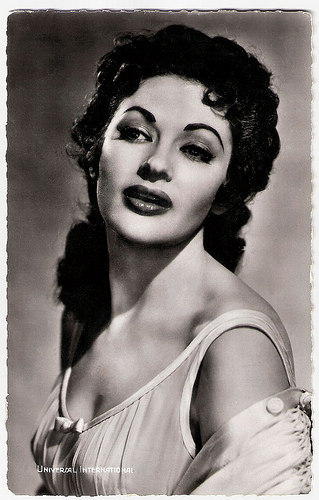
French postcard by Editions du Globe, no. 542. Photo: Universal-International.
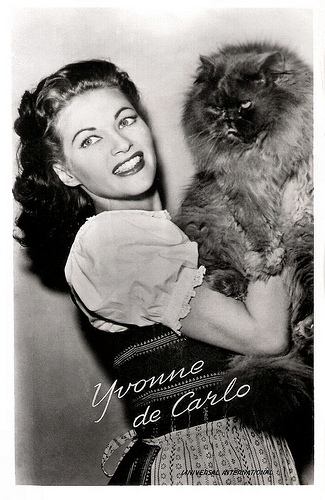
Dutch postcard by Takken, no. 3538. Photo: Universal International, 1949.
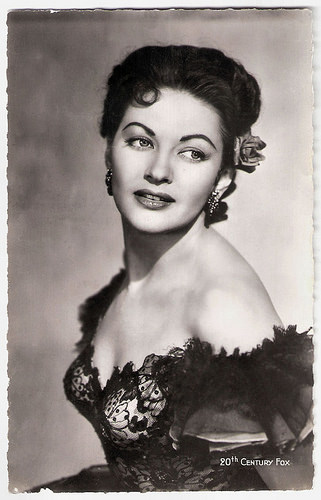
French postcard by Editions du Globe, no. 519. Photo: 20th Century Fox.
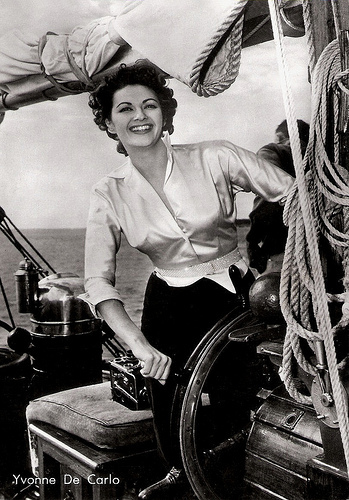
Italian postcard by Bromostampa, Milano, no. 209.
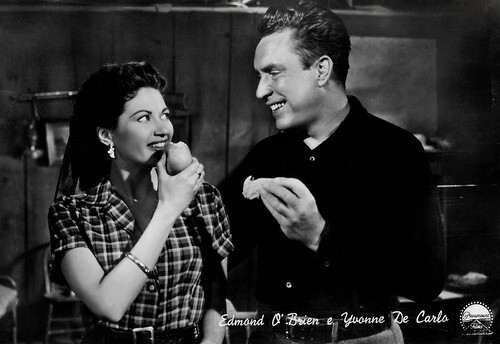
Italian postcard by Bromofoto, Milano, no. 408. Photo: Paramount. Edmond O'Brien and Yvonne De Carlo in Silver City (Byron Haskin, 1951).
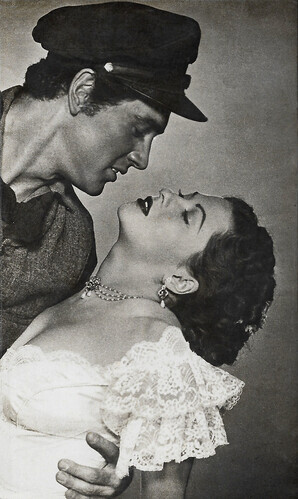
Spanish postcard, no. 598. Rock Hudson and Yvonne De Carlo in Scarlet Angel (Sidney Salkow, 1952).
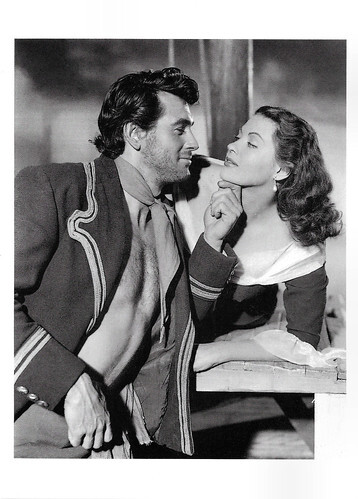
Swiss-German-British postcard by News Productions, Baulmes / Filmwelt Berlin, Bakede / News Productions, Stroud, no. 56493. Rock Hudson and Yvonne De Carlo in Sea Devils (Raoul Walsh, 1952), produced by Coronado (RKO).
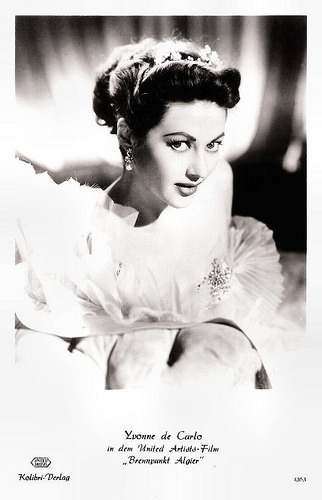
German postcard by Kolibri-Verlag, no. 1363. Photo: United Artists. Publicity still for Fort Algiers (Lesley Selander, 1953).
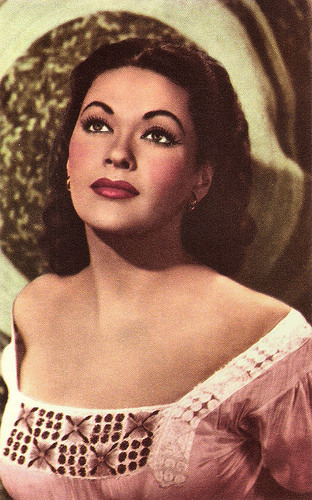
Belgian collectors card by Kwatta, Bois d'Haine, no. C 327. Photo: M.G.M. Publicity still for Sombrero (Norman Forster, 1953).
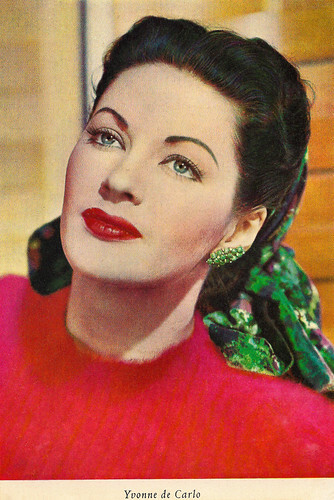
West-German postcard by Wilhelm Schulze-Witteborg Graphischer Betrieb, Wanne-Eickel. Photo: Universal-International-Film.
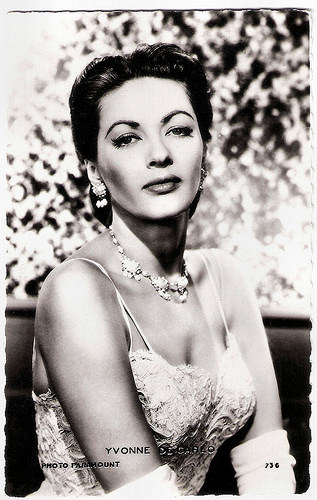
French postcard by Editions P.I., no. 736. Photo: Paramount, 1956.
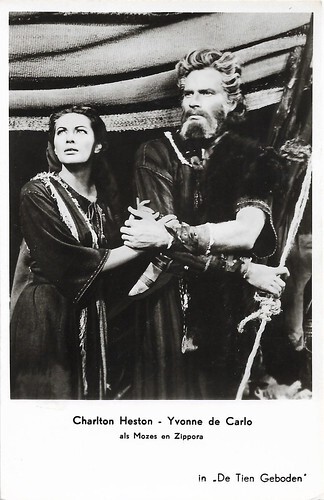
Dutch postcard. Photo: Charlton Heston and Yvonne de Carlo in The Ten Commandments (Cecil B. DeMille, 1956), released in Dutch as De Tien Geboden.
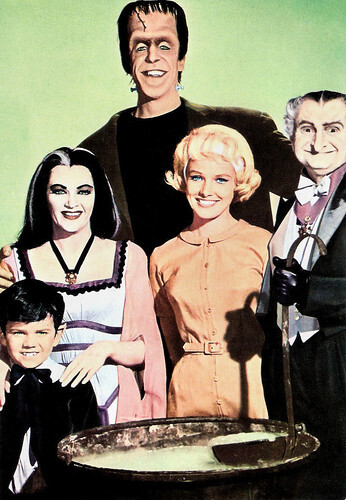
Spanish postcard by Postal Oscarcolor, no. 313. Sent by mail in 1965. Butch Patrick, Yvonne De Carlo, Fred Gwynne, Pat Priest, and Al Lewis in the American TV series The Munsters (1964-1966).
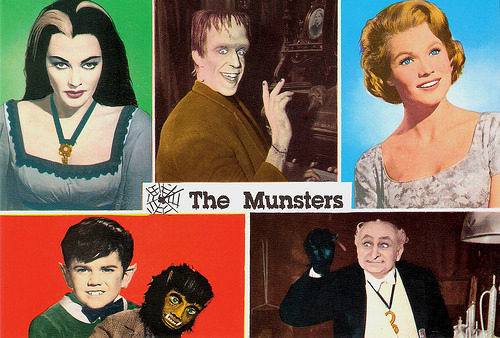
British postcard by Klasik Kards, London, no. 1514. Photos from the TV series The Munsters (1964-1966).
Yvonne De Carlo sings I'll follow you in Fort Algiers (Lesley Selander, 1953) with Carlos Thompson and Raymond Burr. Source: Georges Gradzi (YouTube).
Sources: Wolfgang Saxon (The New York Times), , and Wikipedia.

Spanish postcard in the Hollywood (California) series. Photo: Universal. Publicity still for Salome Where She Danced (Charles Lamont, 1945).

British postcard in the Picturegoer Series, London, no. W 729. Photo: Universal-International.

British postcard in the Picturegoer Series, London, no. D 304. Photo: Paramount.

British postcard in The People series by Show Parade Picture Service, London, no. P. 1021. Photo: Universal-International.

American photo postcard, no. 212.

Spanish postcard, no. 4200. Yvonne De Carlo and Tony Martin in Casbah (John Berry, 1948). Collection: Marlene Pilaete.

Dutch postcard by Takken, no. AX 144. Photo: Universal International. Publicity still for Buccaneer's Girl (Frederick De Cordova, 1950).
The most beautiful girl in the world
Yvonne De Carlo was born Margaret Yvonne Middleton in 1922 in West Point Grey (now part of Vancouver), British Columbia, Canada. She was the only child of William Middleton, an Australian-born salesman, and Marie DeCarlo, a French-born aspiring actress. Her father deserted the home, leaving her mother to make a living as a waitress. When De Carlo was ten her mother enrolled her in a local dance school and also saw that she studied dramatics. De Carlo and her mother travelled to Los Angeles to seek fame and fortune in Hollywood.
In 1940, she was first runner-up to Miss Venice Beach, and she also came fifth in the 1940s Miss California competition. A year later, she landed a bit part as a bathing beauty in Harvard, Here I Come (Lew Landers, 1941). She also appeared in the three-minute Soundies musical, The Lamp of Memory (1942), shown in coin-operated movie jukeboxes. Other roles were slow to follow, and De Carlo took a job in the chorus line of Earl Carroll. During World War II she performed for U.S. servicemen and received many letters from GIs.
She got her big break when she was chosen over a reported 20,000 girls to play the lead role as a European seductress in the Technicolor spectacle Salome, Where She Danced (Charles Lamont, 1945), with Rod Cameron and Walter Slezak . She played a dancer during the Austrian-Prussian war who is forced to flee her country after she is accused of being a spy and ends up in a lawless Western town in Arizona. Producer Walter Wanger described her as "the most beautiful girl in the world." Though not a critical success, it was a box-office favourite, and the heavily-promoted De Carlo was hailed as an up-and-coming star. Universal signed her to a long-term contract.
De Carlo was given a small role in the prison film Brute Force (Jules Dassin, 1947), starring Burt Lancaster . Two years later she was again cast opposite Lancaster in her first important role in the classic Film Noir Criss Cross (Robert Siodmak, 1949). Claudio Carvalho at IMDb : " Burt Lancaster has an outstanding performance in the role of an honest man obsessed with his former wife, who becomes a criminal trying to regain the love of his fickle ex-wife. Yvonne De Carlo is also perfect and very beautiful, in the role of a cold and manipulative woman, being a perfect 'femme-fatale'."
However, Universal preferred to cast De Carlo in more conventional fare, such as Casbah (John Berry, 1948) a musical remake of the 1938 film Algiers, the adventure film River Lady (George Sherman, 1948), and Buccaneer's Girl (Frederick de Cordova, 1950). In the latter, she played a New Orleans singer who becomes involved with a Pirate Lord (Philip Friend).

Italian postcard, no. 358.

Vintage postcard. Photo: Universal. Publicity still for Salome Where She Danced (Charles Lamont, 1945).

Spanish postcard by Archivo Bermejo, Barcelona, no. 3299. Photo: Universal. Yvonne De Carlo in Salome Where She Danced (Charles Lamont, 1945). Collection: Marlene Pilaete.

Belgian postcard by Nieuwe Merksemsche Chocolaterie S.P.R.I., Merksem (Anvers), no. C 24. Photo: Universal. Yvonne De Carlo, Rod Cameron and Beverly Sue Simmons in Frontier Gal (Charles Lamont, 1945).

Belgian postcard by Nieuwe Merksemsche Chocolaterie S.P.R.I., Mersem (Anvers). Photo: Universal.

French postcard by Editions P.I., Paris, no. 298. Photo: Universal.

Dutch postcard by J. Sleding N.V., Amsterdam, no. 1250. Photo: Universal-International.

West-German postcard by Rüdel-Verlag, Hamburg-Bergedorf, no. 542. Photo: J. Arthur Rank Organisation. Yvonne de Carlo in Hotel Sahara (Ken Annakin, 1951).
Lily Munster
When Yvonne De Carlo was in England making Hotel Sahara (Ken Annakin, 1951), she asked Universal to release her contract even though she still had three months to go. The studio agreed. De Carlo had always travelled extensively to promote her films and her appearances were widely publicised. In 1951 she became the first American star to visit Israel. De Carlo regularly played in European films from now on. She starred in the British comedy The Captain's Paradise (Anthony Kimmins, 1953), about a captain of a ferry boat between the restricted British colony in Gibraltar and Spanish Morocco ( Alec Guinness ) who keeps two wives in separate ports. De Carlo of course played the hot-blooded mistress, Nita in Tangiers. She persuaded director Anthony Kimmins to talk Alec Guinness into doing the mambo with her in a nightclub sequence. Guinness, not usually thought of as a physical actor, consented to a week's worth of dance lessons from De Carlo and the sequence is one of the film's highlights.
In England, Yvonne De Carlo also co-starred with David Niven in the comedy Happy Ever After (Mario Zampi, 1954). Her film career reached its peak when director Cecil B. DeMille cast her as Sephora, the wife of Moses ( Charlton Heston ) in his biblical epic The Ten Commandments (1956). It was to be her most prominent role. She later played a lead performance in the Civil War drama Band of Angels (Raoul Walsh, 1957) with Clark Gable , starred as Mary Magdalene in the Italian biblical epic La spada e la croce/The Sword and the Cross (Carlo Ludovico Bragaglia, 1958), with Jorge Mistral and Rossana Podestà , and had a supporting role in the Western McLintock! (Andrew V. McLaglen, 1963) featuring John Wayne .
In 1964, De Carlo was deeply in debt, her film career was over and she was suffering from depression. Then, she was offered the role of Lily Munster, the wife of Herman Munster, in the legendary TV sitcom The Munsters (1964-1966). The Munsters are a weird but honest family. Herman, the father (Fred Gwynne) is Frankenstein's monster. Lily, his wife (Yvonne De Carlo), and the cigar-chomping Grandpa, her father (Al Lewis) are vampires. Their little son Eddie (Butch Patrick) is a werewolf. Their niece Marilyn (Pat Priest) is the only normal one. She is the ugly duck of the family. The sitcom went on the air in 1964 and lasted only two seasons, but achieved a kind of pop-culture immortality in decades of reruns and movie and television spinoffs. Wolfgang Saxon in The New York Times : "In her cape and robes and with a streak of white in her black hair, Miss De Carlo’s Lily was a glamorous ghoul and a kind of Bride of Frankenstein as a homemaker, “dusting” her gothic mansion at 1313 Mockingbird Lane with a vacuum cleaner set on reverse. The humor mostly derived from the family members’ oblivious belief that they were no different from their neighbors." After the show's cancellation, De Carlo reprised the role of Lily Munster in the Technicolor film Munster, Go Home! (Earl Bellamy, 1966).
After 1967, De Carlo became increasingly active in musicals, appearing in off-Broadway productions of 'Pal Joey' and 'Catch Me If You Can'. Her defining stage role was as Carlotta Campion in the original Broadway cast of Stephen Sondheim's musical 'Follies' (1971-1972). Playing a washed-up star at a reunion of old theatre colleagues, she introduced the song 'I'm Still Here', which would become well-known.
Yvonne De Carlo married stuntman Robert Drew Morgan, whom she met on the set of the Western Shotgun (Lesley Selander, 1955). They had two sons, Bruce Ross (1956) and Michael (1957-1997). After Bob Morgan's untimely accident, De Carlo was dismissed from her contract at Metro-Goldwyn-Mayer in 1960. Morgan became an alcoholic and they divorced in 1974. De Carlo kept appearing in films and TV series. After her role in the TV Movie The Barefoot Executive (Susan Seidelman, 1995), she retired from acting at age 72. In 2007, she died from heart failure in Los Angeles. De Carlo was 84.

Vintage postcard. Photo: Universal.

French postcard by Editions du Globe, no. 542. Photo: Universal-International.

Dutch postcard by Takken, no. 3538. Photo: Universal International, 1949.

French postcard by Editions du Globe, no. 519. Photo: 20th Century Fox.

Italian postcard by Bromostampa, Milano, no. 209.

Italian postcard by Bromofoto, Milano, no. 408. Photo: Paramount. Edmond O'Brien and Yvonne De Carlo in Silver City (Byron Haskin, 1951).

Spanish postcard, no. 598. Rock Hudson and Yvonne De Carlo in Scarlet Angel (Sidney Salkow, 1952).

Swiss-German-British postcard by News Productions, Baulmes / Filmwelt Berlin, Bakede / News Productions, Stroud, no. 56493. Rock Hudson and Yvonne De Carlo in Sea Devils (Raoul Walsh, 1952), produced by Coronado (RKO).

German postcard by Kolibri-Verlag, no. 1363. Photo: United Artists. Publicity still for Fort Algiers (Lesley Selander, 1953).

Belgian collectors card by Kwatta, Bois d'Haine, no. C 327. Photo: M.G.M. Publicity still for Sombrero (Norman Forster, 1953).

West-German postcard by Wilhelm Schulze-Witteborg Graphischer Betrieb, Wanne-Eickel. Photo: Universal-International-Film.

French postcard by Editions P.I., no. 736. Photo: Paramount, 1956.

Dutch postcard. Photo: Charlton Heston and Yvonne de Carlo in The Ten Commandments (Cecil B. DeMille, 1956), released in Dutch as De Tien Geboden.

Spanish postcard by Postal Oscarcolor, no. 313. Sent by mail in 1965. Butch Patrick, Yvonne De Carlo, Fred Gwynne, Pat Priest, and Al Lewis in the American TV series The Munsters (1964-1966).

British postcard by Klasik Kards, London, no. 1514. Photos from the TV series The Munsters (1964-1966).
Yvonne De Carlo sings I'll follow you in Fort Algiers (Lesley Selander, 1953) with Carlos Thompson and Raymond Burr. Source: Georges Gradzi (YouTube).
Sources: Wolfgang Saxon (The New York Times), , and Wikipedia.
Published on June 12, 2023 22:00
June 11, 2023
Early Pathé Frères: La belle aux bois dormant (1902)
The Pathé Frères short La belle au bois dormant/The Sleeping Beauty (Lucien Nonguet, Ferdinand Zecca, 1902) was based on the classic fairy tale by Charles Perrault and is probably the oldest film version of the tale. The film was coloured at the ateliers of Segundo De Chomon in Barcelona. Pathé produced a remake in 1908. Croissant in Paris made a series of beautiful hand-coloured postcards for the film.
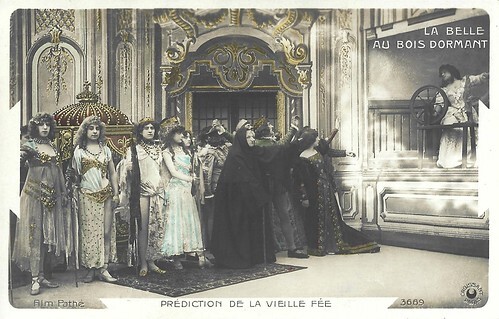
French postcard by Croissant, Paris, no. 3669. Photo: Pathé Frères. Scene from La belle au bois dormant/The Sleeping Beauty (Lucien Nonguet, Ferdinand Zecca, 1902). Caption: Prédiction de vieille fée (The prediction of the old fairy).
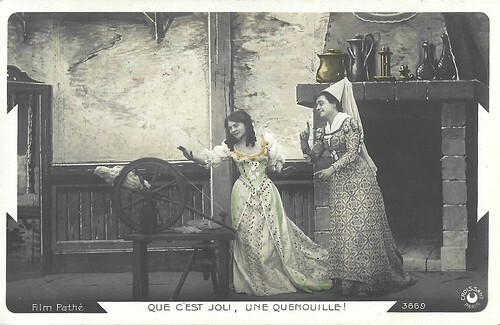
French postcard by Croissant, Paris, no. 3669. Photo: Pathé Frères. Scene from La belle au bois dormant/The Sleeping Beauty (Lucien Nonguet, Ferdinand Zecca, 1902). Caption: Que c'est joli, une quenouille! (How nice, a spinning wheel!).
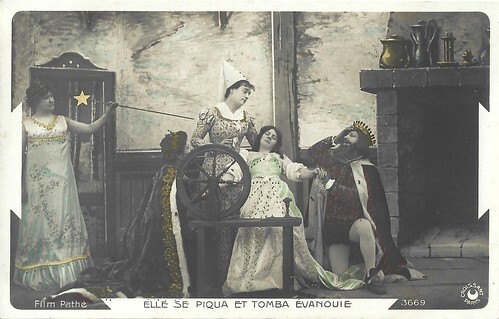
French postcard by Croissant, Paris, no. 3669. Photo: Pathé Frères. Scene from La belle au bois dormant/The Sleeping Beauty (Lucien Nonguet, Ferdinand Zecca, 1902). Caption: Elle se piqua et tomba évanouie (She pricked herself and fell down unconscious).
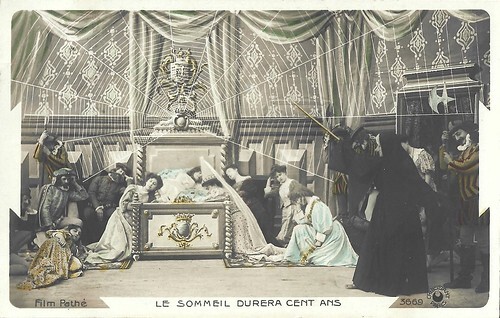
French postcard by Croissant, Paris, no. 3669. Photo: Pathé Frères. Scene from La belle au bois dormant/The Sleeping Beauty (Lucien Nonguet, Ferdinand Zecca, 1902). Caption: Le sommeil durera cent ans (The sleep will last for a hundred years).
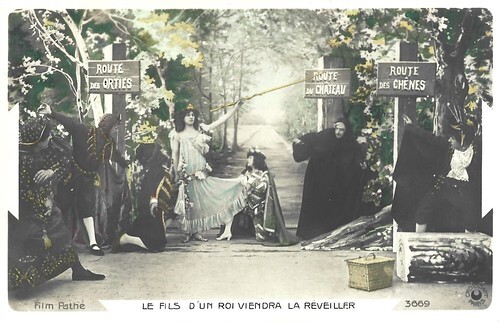
French postcard by Croissant, Paris, no. 3669. Photo: Pathé Frères. Scene from La belle au bois dormant/The Sleeping Beauty (Lucien Nonguet, Ferdinand Zecca, 1902). Caption: Le fils d'un roi viendra la réveiller (The son of a king will wake her up).
A princess cursed by an evil fairy
La belle au bois dormant/The Sleeping Beauty (Lucien Nonguet, Ferdinand Zecca, 1902) was based on the classic fairy tale by Charles Perrault. 'Sleeping Beauty' or 'The Sleeping Beauty in the Woods' or in French 'La belle au bois dormant' is a fairy tale about a princess cursed by an evil fairy. Perrault calls her "Carabosse". The Princess goes to sleep for a hundred years before being awakened by a handsome prince. A good fairy, knowing the princess would be frightened if alone when she wakes, uses her wand to put every living person and animal in the palace and forest asleep, to wake when the princess does.
The earliest known version of the tale is found in the narrative 'Perceforest', written between 1330 and 1344. Another version was published by Giambattista Basile in his collection titled 'The Pentamerone' published posthumously in 1634. Charles Perrault adapted it in 'Histoires ou contes du temps passé' in 1697. The Brothers Grimm included a variant of 'Sleeping Beauty', called 'Dornröschen', in their collection (1812). The version collected and printed by the Brothers Grimm was one orally transmitted from the Perrault version.
Originally, the Perrault tale had a second part in which, years after, the prince has become king and is away. Meanwhile, his mother, who proves to be an ogress, wants to eat the two young royal children Aurore (Dawn) and Jour (Day), and eventually the young mother too, but the cook repeatedly manages to mislead the ogress. When the fraud is discovered, the Queen Mother wants to kill the cook in a tub filled with vipers and other terrible creatures. The king returns just in time and the ogress is thrown in the tub instead. The Grimm brothers used this extension only in an early version of their tale, omitting it afterwards. Most film versions omitted this gruesome part too.
The 1902 Pathé Frères version by Lucien Nonguet and Ferdinand Zecca was probably the oldest film version of the tale. It is unknown who the actors were. Pathé did a remake in 1908, for which the directors, Lucien Nonguet and Albert Capellani, shot the exteriors at the castle of Pierrefonds. This version can easily be found on the net. Many other film versions would follow, of which Disney's Sleeping Beauty (Clyde Geronomi et.al., 1959) may be the best-known one.
In 2005 a German-titled print of the film from the Film Archiv Austria was shown at the Il Cinema Ritrovato festival in Bologna. Mariann Lewinsky wrote in the festival catalogue: "The importance of fairytale films in the production of the time can probably be explained by the fact that children were a very important audience: It was not in dramas and acrobatic films that I put my best hope. It was in fairytales. I made many of them, for children… (Ferdinand Zecca, as quoted by Bousquet)." In 2009 an English-titled print from the National Film and Sound Archive, Australia, was shown at the Giornate del Cinema Muto in Pordenone.
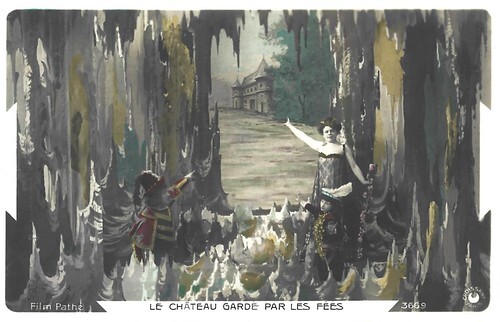
French postcard by Croissant, Paris, no. 3669. Photo: Pathé Frères. Scene from La belle au bois dormant/The Sleeping Beauty (Lucien Nonguet, Ferdinand Zecca, 1902). Caption: Le château gardé par les fées (The castle garded by the fairies).
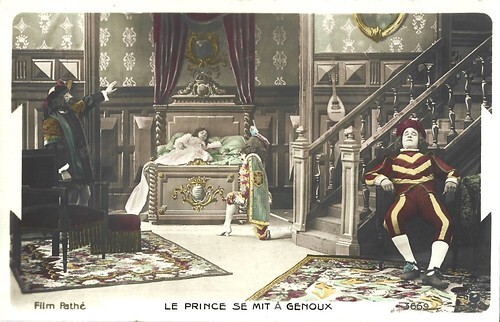
French postcard by Croissant, Paris, no. 3669. Photo: Pathé Frères. Scene from La belle au bois dormant/The Sleeping Beauty (Lucien Nonguet, Ferdinand Zecca, 1902). Caption: Le prince se mit à genoux (The prince kneeled down).
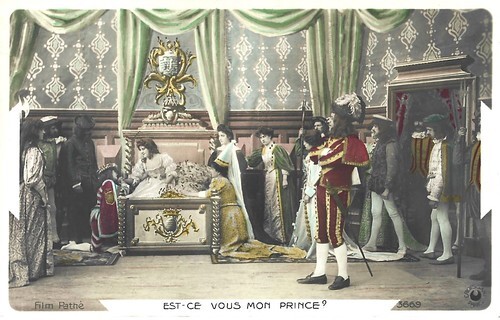
French postcard by Croissant, Paris, no. 3669. Photo: Pathé Frères. Scene from La belle au bois dormant/The Sleeping Beauty (Lucien Nonguet, Ferdinand Zecca, 1902). Caption: Est-ce vous, mon prince? (Is it you, my Prince?).
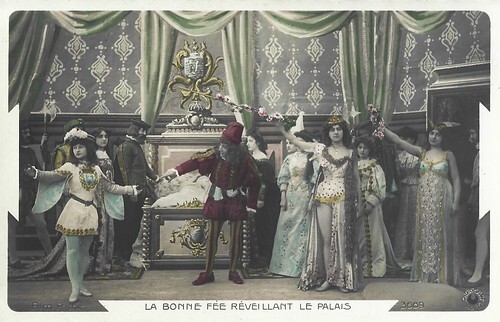
French postcard by Croissant, Paris, no. 3669. Photo: Pathé Frères. Scene from La belle au bois dormant/The Sleeping Beauty (Lucien Nonguet, Ferdinand Zecca, 1902). Caption: La bonne fée réveillant le palais (The good fairy waking up the palace).
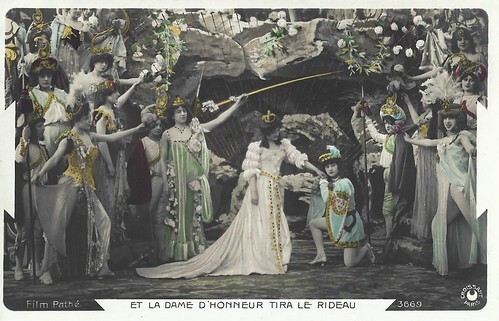
French postcard by Croissant, Paris, no. 3669. Photo: Pathé Frères. Scene from La belle au bois dormant/The Sleeping Beauty (Lucien Nonguet, Ferdinand Zecca, 1902). Caption: Et la dame d'honneur tira le rideau (And the lady-in-waiting lifted the curtain). The image establishes the typical apotheosis of many early fairy-tale films by Pathé and its contemporaries.
Sources: Il Cinema Ritrovato, Cineteca del Friuli and Wikipedia.

French postcard by Croissant, Paris, no. 3669. Photo: Pathé Frères. Scene from La belle au bois dormant/The Sleeping Beauty (Lucien Nonguet, Ferdinand Zecca, 1902). Caption: Prédiction de vieille fée (The prediction of the old fairy).

French postcard by Croissant, Paris, no. 3669. Photo: Pathé Frères. Scene from La belle au bois dormant/The Sleeping Beauty (Lucien Nonguet, Ferdinand Zecca, 1902). Caption: Que c'est joli, une quenouille! (How nice, a spinning wheel!).

French postcard by Croissant, Paris, no. 3669. Photo: Pathé Frères. Scene from La belle au bois dormant/The Sleeping Beauty (Lucien Nonguet, Ferdinand Zecca, 1902). Caption: Elle se piqua et tomba évanouie (She pricked herself and fell down unconscious).

French postcard by Croissant, Paris, no. 3669. Photo: Pathé Frères. Scene from La belle au bois dormant/The Sleeping Beauty (Lucien Nonguet, Ferdinand Zecca, 1902). Caption: Le sommeil durera cent ans (The sleep will last for a hundred years).

French postcard by Croissant, Paris, no. 3669. Photo: Pathé Frères. Scene from La belle au bois dormant/The Sleeping Beauty (Lucien Nonguet, Ferdinand Zecca, 1902). Caption: Le fils d'un roi viendra la réveiller (The son of a king will wake her up).
A princess cursed by an evil fairy
La belle au bois dormant/The Sleeping Beauty (Lucien Nonguet, Ferdinand Zecca, 1902) was based on the classic fairy tale by Charles Perrault. 'Sleeping Beauty' or 'The Sleeping Beauty in the Woods' or in French 'La belle au bois dormant' is a fairy tale about a princess cursed by an evil fairy. Perrault calls her "Carabosse". The Princess goes to sleep for a hundred years before being awakened by a handsome prince. A good fairy, knowing the princess would be frightened if alone when she wakes, uses her wand to put every living person and animal in the palace and forest asleep, to wake when the princess does.
The earliest known version of the tale is found in the narrative 'Perceforest', written between 1330 and 1344. Another version was published by Giambattista Basile in his collection titled 'The Pentamerone' published posthumously in 1634. Charles Perrault adapted it in 'Histoires ou contes du temps passé' in 1697. The Brothers Grimm included a variant of 'Sleeping Beauty', called 'Dornröschen', in their collection (1812). The version collected and printed by the Brothers Grimm was one orally transmitted from the Perrault version.
Originally, the Perrault tale had a second part in which, years after, the prince has become king and is away. Meanwhile, his mother, who proves to be an ogress, wants to eat the two young royal children Aurore (Dawn) and Jour (Day), and eventually the young mother too, but the cook repeatedly manages to mislead the ogress. When the fraud is discovered, the Queen Mother wants to kill the cook in a tub filled with vipers and other terrible creatures. The king returns just in time and the ogress is thrown in the tub instead. The Grimm brothers used this extension only in an early version of their tale, omitting it afterwards. Most film versions omitted this gruesome part too.
The 1902 Pathé Frères version by Lucien Nonguet and Ferdinand Zecca was probably the oldest film version of the tale. It is unknown who the actors were. Pathé did a remake in 1908, for which the directors, Lucien Nonguet and Albert Capellani, shot the exteriors at the castle of Pierrefonds. This version can easily be found on the net. Many other film versions would follow, of which Disney's Sleeping Beauty (Clyde Geronomi et.al., 1959) may be the best-known one.
In 2005 a German-titled print of the film from the Film Archiv Austria was shown at the Il Cinema Ritrovato festival in Bologna. Mariann Lewinsky wrote in the festival catalogue: "The importance of fairytale films in the production of the time can probably be explained by the fact that children were a very important audience: It was not in dramas and acrobatic films that I put my best hope. It was in fairytales. I made many of them, for children… (Ferdinand Zecca, as quoted by Bousquet)." In 2009 an English-titled print from the National Film and Sound Archive, Australia, was shown at the Giornate del Cinema Muto in Pordenone.

French postcard by Croissant, Paris, no. 3669. Photo: Pathé Frères. Scene from La belle au bois dormant/The Sleeping Beauty (Lucien Nonguet, Ferdinand Zecca, 1902). Caption: Le château gardé par les fées (The castle garded by the fairies).

French postcard by Croissant, Paris, no. 3669. Photo: Pathé Frères. Scene from La belle au bois dormant/The Sleeping Beauty (Lucien Nonguet, Ferdinand Zecca, 1902). Caption: Le prince se mit à genoux (The prince kneeled down).

French postcard by Croissant, Paris, no. 3669. Photo: Pathé Frères. Scene from La belle au bois dormant/The Sleeping Beauty (Lucien Nonguet, Ferdinand Zecca, 1902). Caption: Est-ce vous, mon prince? (Is it you, my Prince?).

French postcard by Croissant, Paris, no. 3669. Photo: Pathé Frères. Scene from La belle au bois dormant/The Sleeping Beauty (Lucien Nonguet, Ferdinand Zecca, 1902). Caption: La bonne fée réveillant le palais (The good fairy waking up the palace).

French postcard by Croissant, Paris, no. 3669. Photo: Pathé Frères. Scene from La belle au bois dormant/The Sleeping Beauty (Lucien Nonguet, Ferdinand Zecca, 1902). Caption: Et la dame d'honneur tira le rideau (And the lady-in-waiting lifted the curtain). The image establishes the typical apotheosis of many early fairy-tale films by Pathé and its contemporaries.
Sources: Il Cinema Ritrovato, Cineteca del Friuli and Wikipedia.
Published on June 11, 2023 22:00
June 10, 2023
Ella Raines
Ella Raines (1920-1988) was an American film and television actress with green eyes and high cheekbones. She appeared in many A-pictures very quickly. She starred in four classic Film Noirs directed by Robert Siodmak. In the early 1950s, she had her own TV series, Janet Dean, Registered Nurse (1954), and also had a short-lived recording career during that period.
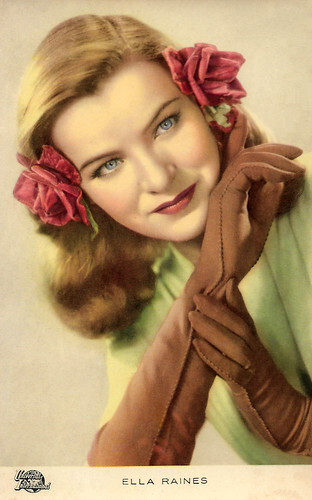
Italian postcard by C.C.M., no. 8. Photo: Universal International.
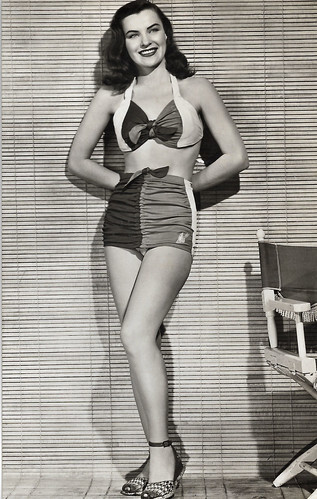
Spanish postcard in the Hollywood (California) series. Photo: Universal International.
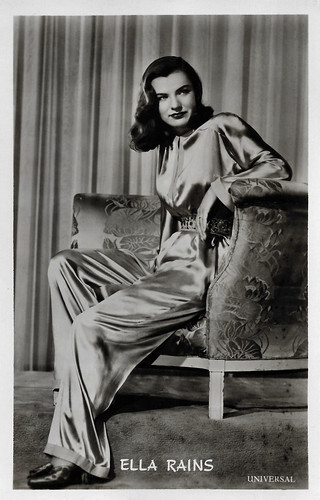
Belgian postcard by Nieuwe Merksemsche Chocolaterie S.P.R.I., Mersem (Anvers). Photo: Universal.
The sole contract star of a $1-million new production company
Ella Raines was born Ella Wallace Raubes in 1920 near Snoqualmie Falls, Washington. She was the youngest of eight children, and her parents, Ernest N. Raines and Bird Zachary Raines owned a general store in the small town. Raines was interested in acting from a young age and appeared in school plays and local theatre productions.
After graduating from high school, she enrolled at the University of Washington as a drama student and participated in many plays. In 1942, a few days after her graduation from the University of Washington, Raines married her high school sweetheart, United States Army Air Forces Major Kenneth William Trout. The couple divorced in 1945.
Ella was appearing in a play when she was seen by film director Howard Hawks. She achieved stardom almost overnight in Hollywood when she was made the sole contract star of a $1-million new production company director Howard Hawks had formed in 1943 with the actor Charles Boyer , B-H Productions. She made her film debut in Corvette K-225 (Richard Rosson, Howard Hawks, 1943) as the love interest of Randolph Scott .
Immediately following her debut, Raines was cast in the all-female war film Cry "Havoc" (Richard Thorpe, 1943) with Margaret Sullavan and Ann Sothern. Raines received critical acclaim for her work in Phantom Lady (Robert Siodmak,1944), which is now considered a classic Film Noir. Next, she played in another classic, the Preston Sturges satire Hail the Conquering Hero (1944) with Eddie Bracken.
Very quickly, she appeared in more A pictures including the Western Tall in the Saddle (Edwin L. Marin, 1944) opposite John Wayne. Raines was now known for her talent, beauty, and versatility as an actress. She went on to star in two more thrillers with Siodmak, The Suspect (Robert Siodmak, 1944) starring Charles Laughton , and The Strange Affair of Uncle Harry (Robert Siodmak, 1945) with George Sanders.

Italian postcard by B.F.F. Editore (Casa Editr. Ballerini & Fratini, Firenze), no. 2151. Photo: Universal International.
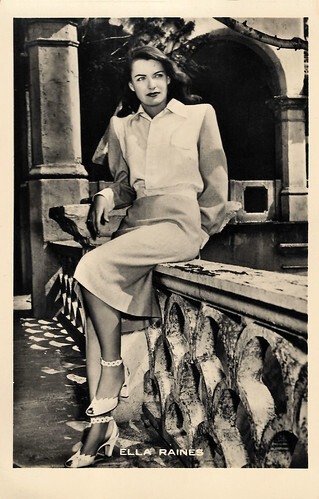
Dutch postcard by Fa. Gebr. van Baalen, Gorinchem.
Starring in a series of interesting Film Noirs
Ella Raines often played strong-willed and intelligent women, and her performances were praised for their depth and complexity. After the war, she starred in a series of interesting Film Noirs, including Time Out of Mind (Robert Siodmak, 1947), The Web (Michael Gordon, 1947), Brute Force (Jules Dassin, 1947) starring Burt Lancaster , and the underrated Impact (Arthur Lubin, 1948) with Brian Donlevy and Charles Coburn.
In 1948, Raines married Robin Olds, a famous fighter pilot, who eventually became promoted to United States Air Force Brigadier General. The couple had three children - their son, Robert Ernest Olds, was stillborn in 1958.
Raines continued to work in film and television throughout the 1950s, appearing in several popular TV shows, including Climax! and Wagon Train. In 1954 and 1955, Ella Raines starred in the television series Janet Dean, Registered Nurse. None of her later pictures was nearly as successful as her earlier movies and her film career began to decline.
She retired in 1956 after filming the British-made thriller The Man in the Road (Lance Comfort, 1956). She focused on her family and philanthropy work. She was actively involved in numerous charitable organisations, including the National Mental Health Association and the March of Dimes. She and her husband separated in 1975 and were divorced in 1976. In the mid-1970s, she returned to her alma mater to teach drama at the University of Washington in Seattle. Ella moved back to Hollywood and lived in Sherman Oaks until her death.
Ella Raines returned once to the screen for a guest role in the crime television series Matt Houston in 1984. Ella Raines passed away in 1988, in Sherman Oaks, California, from throat cancer. She was 67 years old. She was survived by two daughters, Christina Eloise Olds and Susan Olds Scott-Risner, and a granddaughter, Jennifer Newman. Raines left behind a legacy as a talented and versatile actress who made a significant contribution to the film industry during the Golden Age of Hollywood.
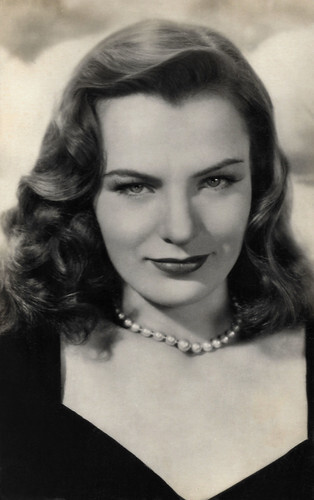
Spanish postcard by Sobe / Soberanas, Barcelona, no. 312.
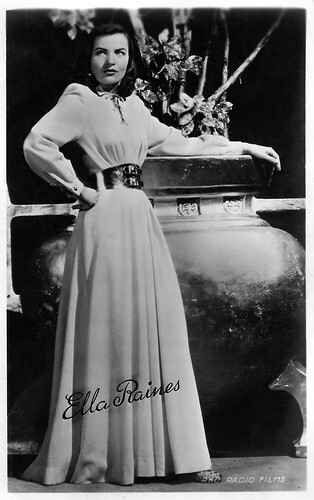
Swedish postcard by Förlag Torsten G. Ericson, Helsingborg, no. 3038. Photo: RKO Radio Films. Sent by mail in 1958.
Sources: (IMDb), Wikipedia (Dutch and English) and .

Italian postcard by C.C.M., no. 8. Photo: Universal International.

Spanish postcard in the Hollywood (California) series. Photo: Universal International.

Belgian postcard by Nieuwe Merksemsche Chocolaterie S.P.R.I., Mersem (Anvers). Photo: Universal.
The sole contract star of a $1-million new production company
Ella Raines was born Ella Wallace Raubes in 1920 near Snoqualmie Falls, Washington. She was the youngest of eight children, and her parents, Ernest N. Raines and Bird Zachary Raines owned a general store in the small town. Raines was interested in acting from a young age and appeared in school plays and local theatre productions.
After graduating from high school, she enrolled at the University of Washington as a drama student and participated in many plays. In 1942, a few days after her graduation from the University of Washington, Raines married her high school sweetheart, United States Army Air Forces Major Kenneth William Trout. The couple divorced in 1945.
Ella was appearing in a play when she was seen by film director Howard Hawks. She achieved stardom almost overnight in Hollywood when she was made the sole contract star of a $1-million new production company director Howard Hawks had formed in 1943 with the actor Charles Boyer , B-H Productions. She made her film debut in Corvette K-225 (Richard Rosson, Howard Hawks, 1943) as the love interest of Randolph Scott .
Immediately following her debut, Raines was cast in the all-female war film Cry "Havoc" (Richard Thorpe, 1943) with Margaret Sullavan and Ann Sothern. Raines received critical acclaim for her work in Phantom Lady (Robert Siodmak,1944), which is now considered a classic Film Noir. Next, she played in another classic, the Preston Sturges satire Hail the Conquering Hero (1944) with Eddie Bracken.
Very quickly, she appeared in more A pictures including the Western Tall in the Saddle (Edwin L. Marin, 1944) opposite John Wayne. Raines was now known for her talent, beauty, and versatility as an actress. She went on to star in two more thrillers with Siodmak, The Suspect (Robert Siodmak, 1944) starring Charles Laughton , and The Strange Affair of Uncle Harry (Robert Siodmak, 1945) with George Sanders.

Italian postcard by B.F.F. Editore (Casa Editr. Ballerini & Fratini, Firenze), no. 2151. Photo: Universal International.

Dutch postcard by Fa. Gebr. van Baalen, Gorinchem.
Starring in a series of interesting Film Noirs
Ella Raines often played strong-willed and intelligent women, and her performances were praised for their depth and complexity. After the war, she starred in a series of interesting Film Noirs, including Time Out of Mind (Robert Siodmak, 1947), The Web (Michael Gordon, 1947), Brute Force (Jules Dassin, 1947) starring Burt Lancaster , and the underrated Impact (Arthur Lubin, 1948) with Brian Donlevy and Charles Coburn.
In 1948, Raines married Robin Olds, a famous fighter pilot, who eventually became promoted to United States Air Force Brigadier General. The couple had three children - their son, Robert Ernest Olds, was stillborn in 1958.
Raines continued to work in film and television throughout the 1950s, appearing in several popular TV shows, including Climax! and Wagon Train. In 1954 and 1955, Ella Raines starred in the television series Janet Dean, Registered Nurse. None of her later pictures was nearly as successful as her earlier movies and her film career began to decline.
She retired in 1956 after filming the British-made thriller The Man in the Road (Lance Comfort, 1956). She focused on her family and philanthropy work. She was actively involved in numerous charitable organisations, including the National Mental Health Association and the March of Dimes. She and her husband separated in 1975 and were divorced in 1976. In the mid-1970s, she returned to her alma mater to teach drama at the University of Washington in Seattle. Ella moved back to Hollywood and lived in Sherman Oaks until her death.
Ella Raines returned once to the screen for a guest role in the crime television series Matt Houston in 1984. Ella Raines passed away in 1988, in Sherman Oaks, California, from throat cancer. She was 67 years old. She was survived by two daughters, Christina Eloise Olds and Susan Olds Scott-Risner, and a granddaughter, Jennifer Newman. Raines left behind a legacy as a talented and versatile actress who made a significant contribution to the film industry during the Golden Age of Hollywood.

Spanish postcard by Sobe / Soberanas, Barcelona, no. 312.

Swedish postcard by Förlag Torsten G. Ericson, Helsingborg, no. 3038. Photo: RKO Radio Films. Sent by mail in 1958.
Sources: (IMDb), Wikipedia (Dutch and English) and .
Published on June 10, 2023 22:00
June 9, 2023
Josephine Dunn
Josephine Dunn (1906-1983) was an American film actress of the 1920s and 1930s.
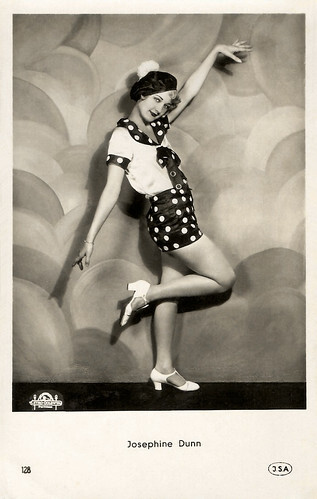
Dutch postcard by J.S.A. (J. Sleding, Amsterdam, no. 128. Photo: Ruth Harriet Louise, 1929 / Metro-Goldwyn-Mayer.
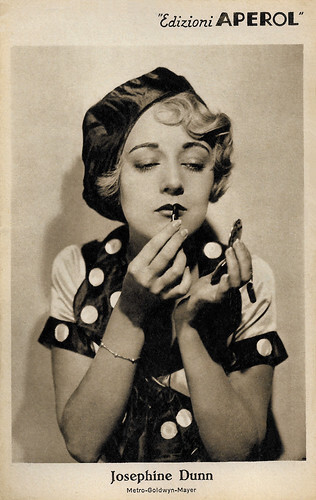
Italian postcard by Edizioni Aperol, Padova. Photo: Ruth Harriet Louise / Metro Goldwyn Mayer.
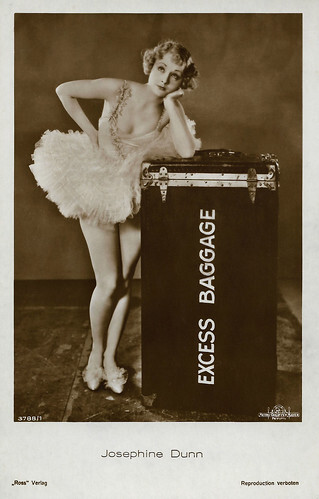
German postcard by Ross Verlag, no. 3788/1, 1928-1929. Photo: Metro-Goldwyn-Mayer. Josephine Dunn in Excess Baggage (James Cruze, 1928).
A ravishing blue-eyed blonde
Mary Josephine Dunn was born in New York City, in 1906. She grew up in her native New York and attended Holy Cross Convent, a Catholic girls' school there. At the age of 14, she became a chorus girl at the Winter Garden Theatre in 'Good Morning, Dearie'. After her first successes, Dunn dropped out of school and from then on devoted herself exclusively to the theatre.
She was briefly in the Ziegfeld Follies and, in 1924, had a walk-on in 'Dear Sir' on Broadway. Two years later, she was picked by a talent scout to join the Paramount acting school for hopeful young debutantes. She began her Hollywood career with a small role alongside Thelma Todd in Fascinating Youth (Sam Wood, 1926).
She graduated from the Paramount Pictures School, which was set up by Paramount Pictures for their young actors without a high school diploma. A ravishing blue-eyed blonde, she made an impression in D.W. Griffith's The Sorrows of Satan (1926). In 1927 Dunn got her first leading role opposite Evelyn Brent in Love's Greatest Mistake (A. Edward Sutherland, 1927).
In 1927, she played the female lead alongside Al Jolson in the Warner Brothers-produced The Singing Fool (1927), a sequel to the hugely successful The Jazz Singer of the same year, but which failed to match the success of its predecessor. After another leading role opposite Wallace Beery in Fireman, Save My Child (A. Edward Sutherland, 1927), she took a nine-month break.
Then she joined Metro-Goldwyn-Mayer and acted in Our Modern Maidens (Jack Conway, 1929) with Joan Crawford and Anita Page . She married Clyde Greathouse during the mid-1920s, divorcing him shortly thereafter. In 1925 she married William P. Cameron, whom she also divorced in 1928. She would star in a total of twenty-three silent films, and in 1929 she was one of thirteen WAMPAS Baby Stars, which that year also included actress Jean Arthur.
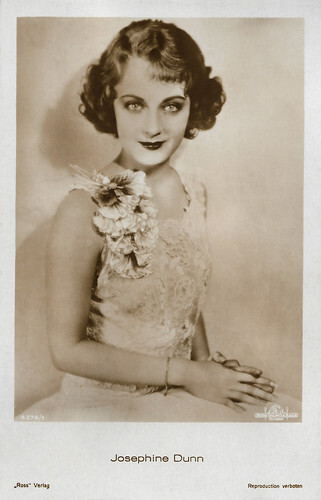
German postcard by Ross Verlag, no. 4274/1, 1929-1930. Photo: Metro Goldwyn Mayer.
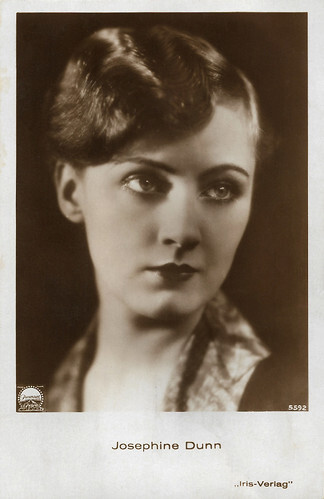
Austrian postcard by Iris-Verlag, no. 5592. Photo: Paramount.
Playing vamps and mercenary wives
In 1930 Josephine Dunn made a successful transition, unlike many silent stars, to sound films. She starred in Safety in Numbers (Victor Schertzinger, 1930) alongside Charles 'Buddy' Rogers and Kathryn Crawford.
She had good reviews in the Ernst Lubitsch -directed operetta One Hour with You (1932) as Mademoiselle Martel. She starred in sixteen films through 1932, and at the peak of her career in 1933 she played vamps and mercenary wives.
That same year, she married Eugene J. Lewis, whom she divorced in 1935 to marry Carroll Case, whose father Frank Case owned the Algonquin Hotel in New York City, which housed the now-famous Algonquin Round Table. In the 1920s, Dunn had already become associated with the Algonquin Round Table, a meeting place for a group of actors, critics, wits, and writers, between 1919 and 1929.
Dunn retired from acting in 1938 and remained with Case for the remainder of his life. She made sporadic appearances in summer stock during the 1940s.
Her husband died in 1978 and Josephine Dunn died 6 years later in 1983, in Thousand Oaks, California, aged 76. The actress was buried alongside her husband in a columbarium at Westwood Village Memorial Park Cemetery.
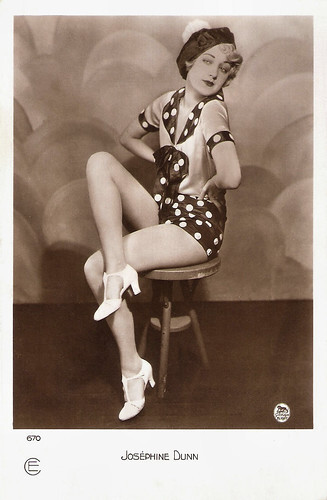
French postcard by Cinémagazine-Edition, Paris, no. 670. Photo: Ruth Harriet Louise / Metro-Goldwyn-Mayer.
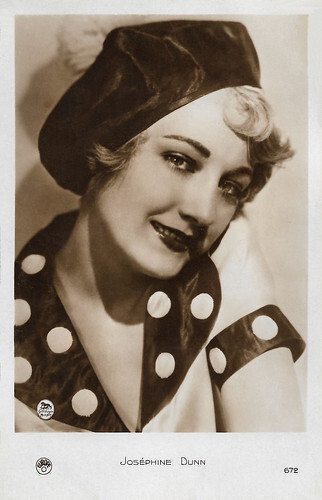
French postcard by Europe, no. 672. Photo: Ruth Harriet Louise, 1929 / Metro-Goldwyn-Mayer.
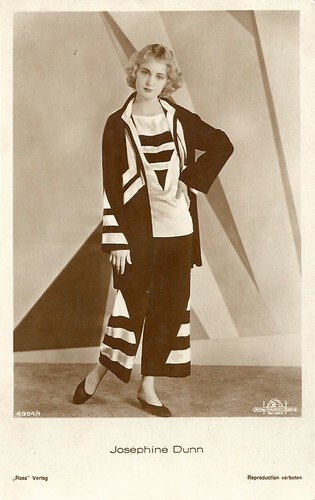
German postcard by Ross Verlag, no. 4904/1, 1929-1930. Photo: Ruth Harriet Louise / Metro-Goldwyn-Mayer.
Wikipedia and .

Dutch postcard by J.S.A. (J. Sleding, Amsterdam, no. 128. Photo: Ruth Harriet Louise, 1929 / Metro-Goldwyn-Mayer.

Italian postcard by Edizioni Aperol, Padova. Photo: Ruth Harriet Louise / Metro Goldwyn Mayer.

German postcard by Ross Verlag, no. 3788/1, 1928-1929. Photo: Metro-Goldwyn-Mayer. Josephine Dunn in Excess Baggage (James Cruze, 1928).
A ravishing blue-eyed blonde
Mary Josephine Dunn was born in New York City, in 1906. She grew up in her native New York and attended Holy Cross Convent, a Catholic girls' school there. At the age of 14, she became a chorus girl at the Winter Garden Theatre in 'Good Morning, Dearie'. After her first successes, Dunn dropped out of school and from then on devoted herself exclusively to the theatre.
She was briefly in the Ziegfeld Follies and, in 1924, had a walk-on in 'Dear Sir' on Broadway. Two years later, she was picked by a talent scout to join the Paramount acting school for hopeful young debutantes. She began her Hollywood career with a small role alongside Thelma Todd in Fascinating Youth (Sam Wood, 1926).
She graduated from the Paramount Pictures School, which was set up by Paramount Pictures for their young actors without a high school diploma. A ravishing blue-eyed blonde, she made an impression in D.W. Griffith's The Sorrows of Satan (1926). In 1927 Dunn got her first leading role opposite Evelyn Brent in Love's Greatest Mistake (A. Edward Sutherland, 1927).
In 1927, she played the female lead alongside Al Jolson in the Warner Brothers-produced The Singing Fool (1927), a sequel to the hugely successful The Jazz Singer of the same year, but which failed to match the success of its predecessor. After another leading role opposite Wallace Beery in Fireman, Save My Child (A. Edward Sutherland, 1927), she took a nine-month break.
Then she joined Metro-Goldwyn-Mayer and acted in Our Modern Maidens (Jack Conway, 1929) with Joan Crawford and Anita Page . She married Clyde Greathouse during the mid-1920s, divorcing him shortly thereafter. In 1925 she married William P. Cameron, whom she also divorced in 1928. She would star in a total of twenty-three silent films, and in 1929 she was one of thirteen WAMPAS Baby Stars, which that year also included actress Jean Arthur.

German postcard by Ross Verlag, no. 4274/1, 1929-1930. Photo: Metro Goldwyn Mayer.

Austrian postcard by Iris-Verlag, no. 5592. Photo: Paramount.
Playing vamps and mercenary wives
In 1930 Josephine Dunn made a successful transition, unlike many silent stars, to sound films. She starred in Safety in Numbers (Victor Schertzinger, 1930) alongside Charles 'Buddy' Rogers and Kathryn Crawford.
She had good reviews in the Ernst Lubitsch -directed operetta One Hour with You (1932) as Mademoiselle Martel. She starred in sixteen films through 1932, and at the peak of her career in 1933 she played vamps and mercenary wives.
That same year, she married Eugene J. Lewis, whom she divorced in 1935 to marry Carroll Case, whose father Frank Case owned the Algonquin Hotel in New York City, which housed the now-famous Algonquin Round Table. In the 1920s, Dunn had already become associated with the Algonquin Round Table, a meeting place for a group of actors, critics, wits, and writers, between 1919 and 1929.
Dunn retired from acting in 1938 and remained with Case for the remainder of his life. She made sporadic appearances in summer stock during the 1940s.
Her husband died in 1978 and Josephine Dunn died 6 years later in 1983, in Thousand Oaks, California, aged 76. The actress was buried alongside her husband in a columbarium at Westwood Village Memorial Park Cemetery.

French postcard by Cinémagazine-Edition, Paris, no. 670. Photo: Ruth Harriet Louise / Metro-Goldwyn-Mayer.

French postcard by Europe, no. 672. Photo: Ruth Harriet Louise, 1929 / Metro-Goldwyn-Mayer.

German postcard by Ross Verlag, no. 4904/1, 1929-1930. Photo: Ruth Harriet Louise / Metro-Goldwyn-Mayer.
Wikipedia and .
Published on June 09, 2023 22:00
June 8, 2023
Chubby Checker
American singer-songwriter Chubby Checker (1941) popularised the dance style Twist, with his 1960 hit cover of Hank Ballard's R & B hit 'The Twist'. In September 2008, 'The Twist' topped Billboard's list of the most popular singles to have appeared in the Hot 100 since its debut in 1958.

Vintage postcard, no. 6.

Dutch promotion card by Bovema, Heemstede. Photo: Columbia.

German postcard by Krüger, no. 902/273. Photo: Ariola.
The uncrowned King of Twist
Chubby Checker was born in 1941, in Andrews of Spring Gulley, South Carolina, as Ernest Evans. From an early age, he learned to play the piano, played the drums and imitated several singers. At South Philadelphia High School where Frankie Avalon also attended, he made up dances for school performances with his school friend Fabian Forte .
Initially, Ernest worked at a poulterer's, where the owner (Henry Colt) took every opportunity to demonstrate Ernest's singing skills. After appearing on a Christmas gift record in late 1958, imitating various stars (Fats Domino, the Coasters, Elvis Presley , Cozy Cole and The Chipmunks), he was offered a contract with Cameo-Parkway in early 1959, where the record 'The Class' was immediately released on single.
He got his stage name from his childhood nickname, "Chubby," and his Fats Domino imitations, which gave rise to the pun and alliteration Chubby Checker (checkers is as well as domino a game). Hank Ballard and the Midnighters recorded the original version of 'The Twist' as the B-side of 'Teardrops on Your Letter' in 1958.
This record was accompanied by a dance to liven up their performance at The Peacock Club in Atlanta. Although the song seemed to appeal to the audience, several attempts to do something with it came to nothing. When Chubby sang the song in June 1959, Cameo-Parkway rated it a B-side.
Through Checker's persistence, he not only lost 15 kilos by performing a lot, but 'The Twist' eventually became a number 1 hit in 1960, and the record stayed listed for over 16 weeks. It sparked a dance craze that swept the nation. The song gave Checker his breakthrough and his title as the uncrowned King of Twist. In 1961, 'The Twist' rose to number one for a second time and stayed there for 18 weeks. The song has since been covered by numerous artists.
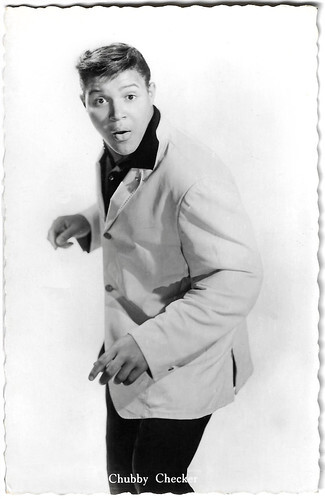
Vintage postcard, no. 362.
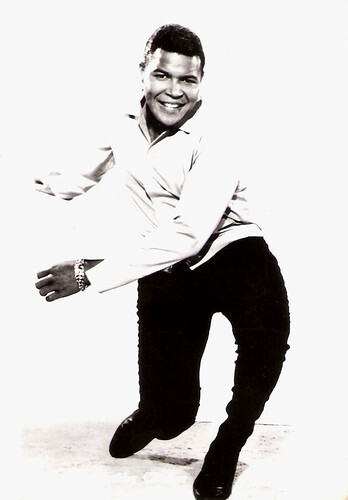
Dutch postcard by Gebr. Spanjersberg N.V., Rotterdam. Sent by mail in 1964.
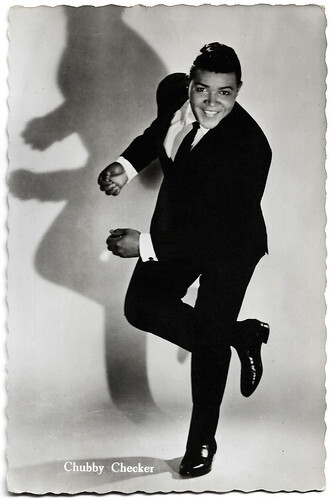
Vintage postcard, no. 662.
Inducted into the Rock and Roll Hall of Fame
Chubby Checker's success with 'The Twist' was followed by numerous variations on the twist and similar dances. When Don Covay and John Berry released 'Pony Time' with The Goodtimers in 1960 and achieved some local success with it, it was almost immediately covered by Chubby Checker. Checker's version rose to number 1 and stayed listed for 16 weeks in 1961. Checker went on to have other hits, including 'Let's Twist Again' and 'Limbo Rock'. His success with 'The Twist' also led to several television appearances, including on American Bandstand with Dick Clark.
Chubby Checker made his film debut as a performer in the musical Teenage Millionaire (Lawrence Doheny, 1961) with Rocky Graziano and Zasu Pitts. It was followed by Twist Around the Clock (Oscar Rudolph, 1961) with Dion and Don't Knock the Twist (Oscar Rudolph, 1962) with Mari Blanchard . After 1963, the dance hype was a bit over and Checker concentrated on Europe, which was a bit behind the US in terms of music. There he performed in the Austrian film Die ganze Welt ist himmelblau/The whole world is sky blue (Franz Antel, 1964) with Johanna Matz and Peter Weck and the British film The Comedy Man (Alvin Rakoff, 1964) with Kenneth More and Dennis Price.
At the German Bierfeste, he met Dutch Catharina 'Rina' Lodders, the 1962 Miss World. En passant, following Elvis Presley with 'Muss I denn' (Wooden heart), he recorded the German children's folk song 'Good old Schwäbische Eisenbahn', better known as 'Troola, troola, troola la'. The b-side is 'Autobahn Baby'. He married Lodders in 1964. From the marriage, three children were born and the family lived in a Philadelphia suburb. Together with the Dutch pop group ZZ en de Maskers, he recorded the 1965 hits 'Baby Baby Balla Balla' and 'Stopping in Las Vegas', which ZZ and the Masks previously recorded as 'Sloppin' in Las Vegas'.
He continued to perform and record throughout the 1960s and beyond. In 1970, Checker and three others were arrested near Niagara Falls when drugs were found in their car. In 1983, his illegitimate daughter Mistie Williams was born. She later made it to professional basketball player with the Houston Comets in the Women's National Basketball Association. In 1986 Chubby was inducted into the Rock and Roll Hall of Fame and in 1988, 'The Twist' became a hit for the third time, this time with the Fat Boys. The song reached 16th place in the charts.
He incidentally appeared on the screen as himself in such films as Purple People Eater (Linda Shayne, 1988) with Ned Beatty and Calendar Girl (John Whitesell, 1993) with Jason Priestley. In 2000, he started a wholesale snack business called The Last Twist, Inc. and Chubby Checker Snacks. He also introduced the Checkerlicious Express, a driving snack roadshow with Checker himself at the wheel. In 2007, 'Knock Down The Walls' became a hit in the US. Today, Chubby Checker is still performing and is regarded as a rock and roll pioneer and a cultural icon of the 1960s.
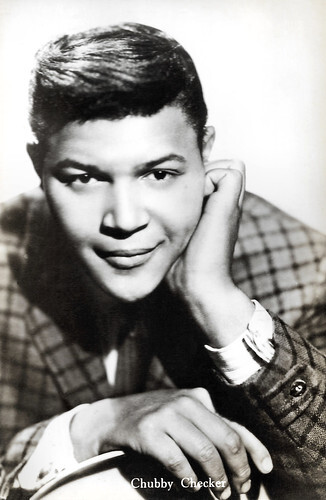
Dutch postcard by Hercules, Haarlem, no. 262. Photo: Columbia.
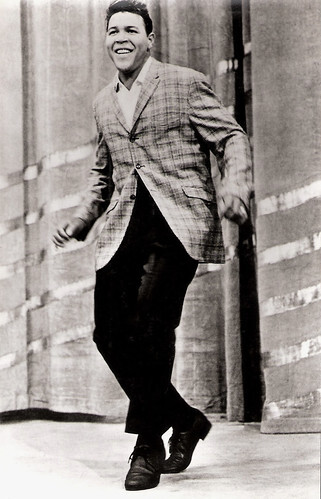
Dutch postcard by Gebr. Spanjersberg, N.V., Rotterdam, no. 269.
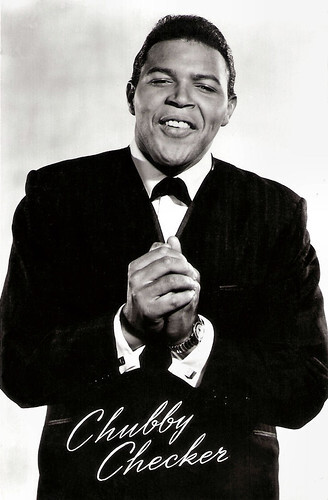
Dutch postcard by Uitgeverij Takken, Utrecht, no. AX 4950.
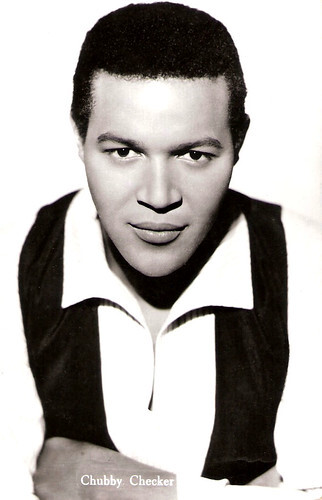
Dutch postcard by Gebr. Spanjersberg N.V., Rotterdam, no. 1087. Photo: Artone.
Source: Wikipedia (Dutch and English) and .

Vintage postcard, no. 6.

Dutch promotion card by Bovema, Heemstede. Photo: Columbia.

German postcard by Krüger, no. 902/273. Photo: Ariola.
The uncrowned King of Twist
Chubby Checker was born in 1941, in Andrews of Spring Gulley, South Carolina, as Ernest Evans. From an early age, he learned to play the piano, played the drums and imitated several singers. At South Philadelphia High School where Frankie Avalon also attended, he made up dances for school performances with his school friend Fabian Forte .
Initially, Ernest worked at a poulterer's, where the owner (Henry Colt) took every opportunity to demonstrate Ernest's singing skills. After appearing on a Christmas gift record in late 1958, imitating various stars (Fats Domino, the Coasters, Elvis Presley , Cozy Cole and The Chipmunks), he was offered a contract with Cameo-Parkway in early 1959, where the record 'The Class' was immediately released on single.
He got his stage name from his childhood nickname, "Chubby," and his Fats Domino imitations, which gave rise to the pun and alliteration Chubby Checker (checkers is as well as domino a game). Hank Ballard and the Midnighters recorded the original version of 'The Twist' as the B-side of 'Teardrops on Your Letter' in 1958.
This record was accompanied by a dance to liven up their performance at The Peacock Club in Atlanta. Although the song seemed to appeal to the audience, several attempts to do something with it came to nothing. When Chubby sang the song in June 1959, Cameo-Parkway rated it a B-side.
Through Checker's persistence, he not only lost 15 kilos by performing a lot, but 'The Twist' eventually became a number 1 hit in 1960, and the record stayed listed for over 16 weeks. It sparked a dance craze that swept the nation. The song gave Checker his breakthrough and his title as the uncrowned King of Twist. In 1961, 'The Twist' rose to number one for a second time and stayed there for 18 weeks. The song has since been covered by numerous artists.

Vintage postcard, no. 362.

Dutch postcard by Gebr. Spanjersberg N.V., Rotterdam. Sent by mail in 1964.

Vintage postcard, no. 662.
Inducted into the Rock and Roll Hall of Fame
Chubby Checker's success with 'The Twist' was followed by numerous variations on the twist and similar dances. When Don Covay and John Berry released 'Pony Time' with The Goodtimers in 1960 and achieved some local success with it, it was almost immediately covered by Chubby Checker. Checker's version rose to number 1 and stayed listed for 16 weeks in 1961. Checker went on to have other hits, including 'Let's Twist Again' and 'Limbo Rock'. His success with 'The Twist' also led to several television appearances, including on American Bandstand with Dick Clark.
Chubby Checker made his film debut as a performer in the musical Teenage Millionaire (Lawrence Doheny, 1961) with Rocky Graziano and Zasu Pitts. It was followed by Twist Around the Clock (Oscar Rudolph, 1961) with Dion and Don't Knock the Twist (Oscar Rudolph, 1962) with Mari Blanchard . After 1963, the dance hype was a bit over and Checker concentrated on Europe, which was a bit behind the US in terms of music. There he performed in the Austrian film Die ganze Welt ist himmelblau/The whole world is sky blue (Franz Antel, 1964) with Johanna Matz and Peter Weck and the British film The Comedy Man (Alvin Rakoff, 1964) with Kenneth More and Dennis Price.
At the German Bierfeste, he met Dutch Catharina 'Rina' Lodders, the 1962 Miss World. En passant, following Elvis Presley with 'Muss I denn' (Wooden heart), he recorded the German children's folk song 'Good old Schwäbische Eisenbahn', better known as 'Troola, troola, troola la'. The b-side is 'Autobahn Baby'. He married Lodders in 1964. From the marriage, three children were born and the family lived in a Philadelphia suburb. Together with the Dutch pop group ZZ en de Maskers, he recorded the 1965 hits 'Baby Baby Balla Balla' and 'Stopping in Las Vegas', which ZZ and the Masks previously recorded as 'Sloppin' in Las Vegas'.
He continued to perform and record throughout the 1960s and beyond. In 1970, Checker and three others were arrested near Niagara Falls when drugs were found in their car. In 1983, his illegitimate daughter Mistie Williams was born. She later made it to professional basketball player with the Houston Comets in the Women's National Basketball Association. In 1986 Chubby was inducted into the Rock and Roll Hall of Fame and in 1988, 'The Twist' became a hit for the third time, this time with the Fat Boys. The song reached 16th place in the charts.
He incidentally appeared on the screen as himself in such films as Purple People Eater (Linda Shayne, 1988) with Ned Beatty and Calendar Girl (John Whitesell, 1993) with Jason Priestley. In 2000, he started a wholesale snack business called The Last Twist, Inc. and Chubby Checker Snacks. He also introduced the Checkerlicious Express, a driving snack roadshow with Checker himself at the wheel. In 2007, 'Knock Down The Walls' became a hit in the US. Today, Chubby Checker is still performing and is regarded as a rock and roll pioneer and a cultural icon of the 1960s.

Dutch postcard by Hercules, Haarlem, no. 262. Photo: Columbia.

Dutch postcard by Gebr. Spanjersberg, N.V., Rotterdam, no. 269.

Dutch postcard by Uitgeverij Takken, Utrecht, no. AX 4950.

Dutch postcard by Gebr. Spanjersberg N.V., Rotterdam, no. 1087. Photo: Artone.
Source: Wikipedia (Dutch and English) and .
Published on June 08, 2023 22:00
June 7, 2023
Fräulein Else (1929)
Fräulein Else/Miss Else (1929) was Elisabeth Bergner's last silent film. It was based on Arthur Schnitzler's novella of the same name.
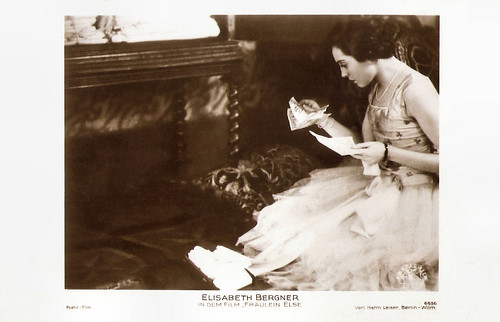
German postcard by Verlag Hermann Leiser, Berlin-Wilm, no. 6656. Photo: Poetic-Film. Elisabeth Bergner in Fräulein Else/Miss Else (Paul Czinner, 1929).
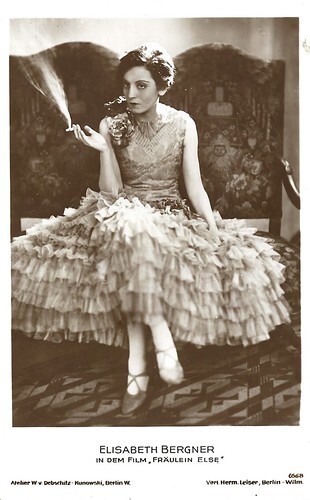
German postcard by Verlag Hermann Leiser, Berlin-Wilm, no. 6568. Photo: Atelier W.v. Debschitz-Kunowski, Berlin. Elisabeth Bergner in Fräulein Else/Miss Else (Paul Czinner, 1929).
Clad only in a white fur coat
In Fräulein Else/Miss Else, Elisabeth Bergner plays the carefree daughter of a Viennese lawyer. She is spending a happy winter holiday in St. Moritz, with her cousin Paul ( Jack Trevor ) and his mother ( Adele Sandrock ).
Then she receives the news that her father ( Albert Bassermann ) is in financial distress: he has gambled away his clients' money on the stock exchange. Only the wealthy art dealer Von Dorsday (Albert Steinrück), who is also in St. Moritz and has his eye on Else, could save him.
Else asks him for the money, but he sets one condition. He wants to see Else naked. She struggles with her decision. Finally, she takes poison and goes to him, clad only in a white fur coat. In the hotel bar, in front of everyone, she lets the coat slip down before his eyes and dies.
Fräulein Else was scripted by Paul Czinner and Béla Balázs, and cinematographed by Karl Freund, Adolf Schlasy and Robert Baberske. Exteriors were shot in Vienna and St. Moritz. The German premiere took place on 7 March 1929 at the Berlin cinema Capitol.
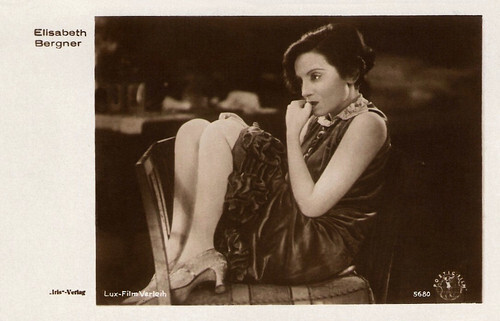
Austrian postcard by Iris Verlag, no. 5689. Photo: Poetic Film/Lux-Film Verleih. Elisabeth Bergner in Fräulein Else (Paul Czinner, 1929).
The great creator of soulful nuances
While the Geman press was extremely laudatory about Bergner and Czinner's previous films such as Liebe (1927) and Dona Juana (1928), it was more critical of this film. Unjustly perhaps, for when we saw the film in 2004 at the Cinema Ritrovato festival in Bologna, it was a heartbreaking film, that well expresses all of the mise-en-scene and cinematographic mastery of late 1920s German cinema.
Rudolf Kurtz in Lichtbild-Bühne, 8 March 1929: "The renunciation of all noisy, theatrical effects leads Czinner to seek his effects with quiet, dramatic means. He masters the register of retardation: it is excellently done how Bergner does not dare to address the brutal fellow, how she runs after him, turns away, approaches again, disappears behind a pillar, again a few steps forward - until the final meeting seems almost like a dramatic redemption.
Czinner uses the same means to stage the end, when the Bergner goes into the art dealer's room, does not find him, and pursues him - while the poison is already destroying her vital forces. Czinner has written the manuscript with a haunting rigidity for Elisabeth Bergner , as he conceives her. For him, she is the great creator of soulful nuances, of delicately passing spiritual subtlety, a person who expresses her inner self completely with rare art.
This is undoubtedly Bergner's strength, but this art alone does not provide the prerequisites for an effective film. Film effect is a dramatic effect with optical means: and what Bergner needs above all is the strong, firmly established dramatic framework into which she can fit, which provides the possibilities for her skill, and at the same time engages the spectator in the structure of a plot that goes to the heart.
It must be said again and again: Bergner is a great possession of German cinema. There is hardly an actress in the whole world whose face, whose body is such a pure expression of her inner life. With an inconceivable clarity, the sorrow and joy of her soul speak from her expression; here is a precious material that can only be classified in cinematic occasions with a strong hand. Only an artist of high rank is able to create an inner tension with pictorial monologues, without a partner, relying only on herself, which has a genuinely dramatic effect."
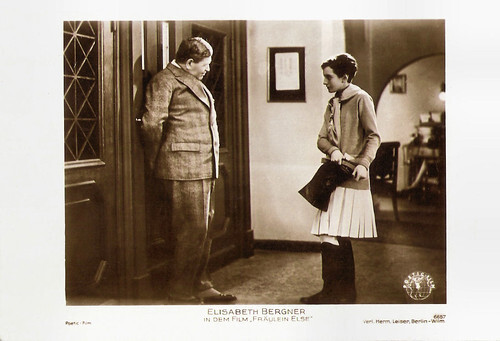
German postcard by Verlag Herm. Leiser, Berlin-Wilm, no. 6657. Photo: Poetic-Film. Albert Steinrück and Elisabeth Bergner in Fräulein Else/Miss Else (Paul Czinner, 1929).
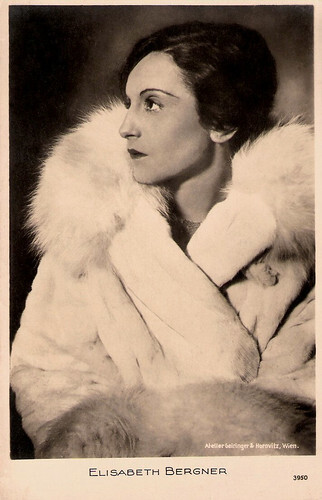
Vintage postcard, no. 3950. Photo: Atelier Geiringer & Horovitz (Trude Geiringer & Dora Horovitz), Wien. Bergner wears the fur coat from the final scene in Fräulein Else.
Sources: Filmportal (German), Wikipedia (German) and IMDb.

German postcard by Verlag Hermann Leiser, Berlin-Wilm, no. 6656. Photo: Poetic-Film. Elisabeth Bergner in Fräulein Else/Miss Else (Paul Czinner, 1929).

German postcard by Verlag Hermann Leiser, Berlin-Wilm, no. 6568. Photo: Atelier W.v. Debschitz-Kunowski, Berlin. Elisabeth Bergner in Fräulein Else/Miss Else (Paul Czinner, 1929).
Clad only in a white fur coat
In Fräulein Else/Miss Else, Elisabeth Bergner plays the carefree daughter of a Viennese lawyer. She is spending a happy winter holiday in St. Moritz, with her cousin Paul ( Jack Trevor ) and his mother ( Adele Sandrock ).
Then she receives the news that her father ( Albert Bassermann ) is in financial distress: he has gambled away his clients' money on the stock exchange. Only the wealthy art dealer Von Dorsday (Albert Steinrück), who is also in St. Moritz and has his eye on Else, could save him.
Else asks him for the money, but he sets one condition. He wants to see Else naked. She struggles with her decision. Finally, she takes poison and goes to him, clad only in a white fur coat. In the hotel bar, in front of everyone, she lets the coat slip down before his eyes and dies.
Fräulein Else was scripted by Paul Czinner and Béla Balázs, and cinematographed by Karl Freund, Adolf Schlasy and Robert Baberske. Exteriors were shot in Vienna and St. Moritz. The German premiere took place on 7 March 1929 at the Berlin cinema Capitol.

Austrian postcard by Iris Verlag, no. 5689. Photo: Poetic Film/Lux-Film Verleih. Elisabeth Bergner in Fräulein Else (Paul Czinner, 1929).
The great creator of soulful nuances
While the Geman press was extremely laudatory about Bergner and Czinner's previous films such as Liebe (1927) and Dona Juana (1928), it was more critical of this film. Unjustly perhaps, for when we saw the film in 2004 at the Cinema Ritrovato festival in Bologna, it was a heartbreaking film, that well expresses all of the mise-en-scene and cinematographic mastery of late 1920s German cinema.
Rudolf Kurtz in Lichtbild-Bühne, 8 March 1929: "The renunciation of all noisy, theatrical effects leads Czinner to seek his effects with quiet, dramatic means. He masters the register of retardation: it is excellently done how Bergner does not dare to address the brutal fellow, how she runs after him, turns away, approaches again, disappears behind a pillar, again a few steps forward - until the final meeting seems almost like a dramatic redemption.
Czinner uses the same means to stage the end, when the Bergner goes into the art dealer's room, does not find him, and pursues him - while the poison is already destroying her vital forces. Czinner has written the manuscript with a haunting rigidity for Elisabeth Bergner , as he conceives her. For him, she is the great creator of soulful nuances, of delicately passing spiritual subtlety, a person who expresses her inner self completely with rare art.
This is undoubtedly Bergner's strength, but this art alone does not provide the prerequisites for an effective film. Film effect is a dramatic effect with optical means: and what Bergner needs above all is the strong, firmly established dramatic framework into which she can fit, which provides the possibilities for her skill, and at the same time engages the spectator in the structure of a plot that goes to the heart.
It must be said again and again: Bergner is a great possession of German cinema. There is hardly an actress in the whole world whose face, whose body is such a pure expression of her inner life. With an inconceivable clarity, the sorrow and joy of her soul speak from her expression; here is a precious material that can only be classified in cinematic occasions with a strong hand. Only an artist of high rank is able to create an inner tension with pictorial monologues, without a partner, relying only on herself, which has a genuinely dramatic effect."

German postcard by Verlag Herm. Leiser, Berlin-Wilm, no. 6657. Photo: Poetic-Film. Albert Steinrück and Elisabeth Bergner in Fräulein Else/Miss Else (Paul Czinner, 1929).

Vintage postcard, no. 3950. Photo: Atelier Geiringer & Horovitz (Trude Geiringer & Dora Horovitz), Wien. Bergner wears the fur coat from the final scene in Fräulein Else.
Sources: Filmportal (German), Wikipedia (German) and IMDb.
Published on June 07, 2023 22:00
June 6, 2023
Varischi & Artico
In 1900, Italian photographers Arturo Varischi and Giovanni Artico assumed ownership of the L. Ricci portrait studio where they had both trained as employees. Varischi & Artico gained a reputation for infant portraits and for their ability to attract famous actors like Lyda Borelli, Irma Gramatica and Tina di Lorenzo, but also musicians, singers, and writers to their studio. For this post, we selected 25 film and stage star postcards with portraits by Varischi & Artico.
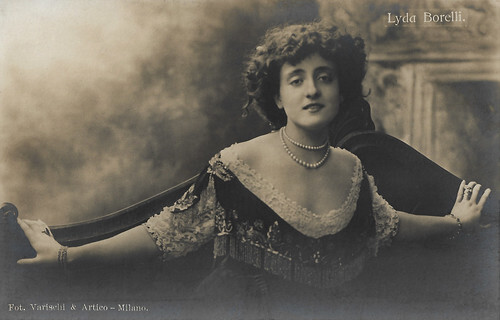
Italian postcard. Photo: Varischi & Artico. Lyda Borelli .
Lyda Borelli (1887-1959) was already an acclaimed stage actress before she became the first diva of Italian silent cinema. The fascinating film star caused a craze among female fans called 'Borellismo'.
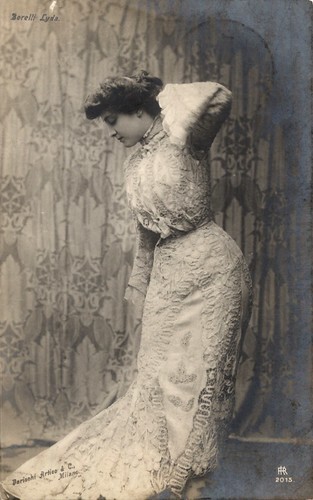
Italian postcard by RA, no. 2015. Photo: Varischi Artico & Co., Milano. Lyda Borelli .
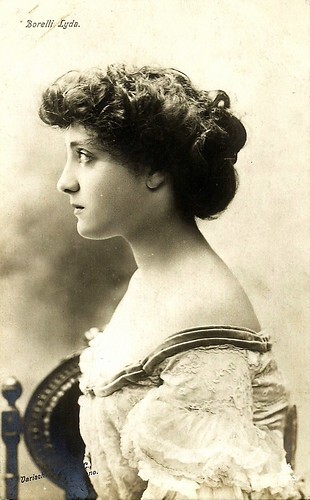
Italian postcard by RA, no. 2023. Photo: Varischi Artico & Co, Milano. Lyda Borelli .
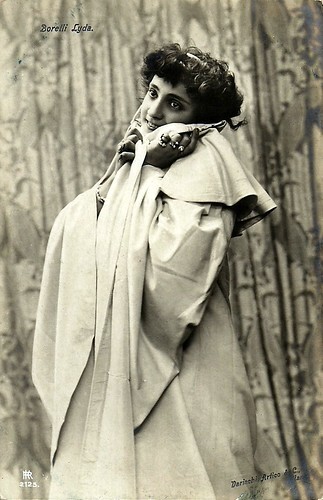
Italian postcard by RA, no. 2125. Photo: Varischi Artico & Co., Milano. Lyda Borelli .
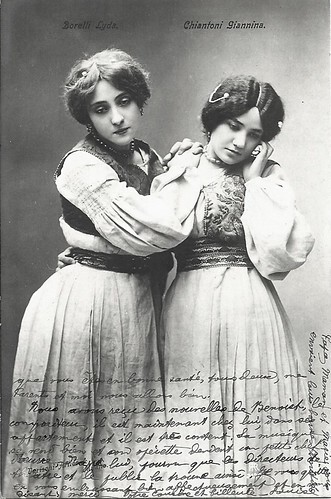
Italian postcard by RA, no. 2120. Photo: Varischi Artico & Co, Milano. Lyda Borelli and Giannina Chiantoni in Gabriele D'Annunzio's stage play 'La figlia di Jorio' (1904)
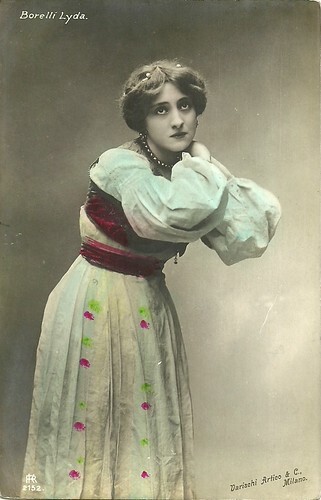
Italian postcard by RA, no. 2152. Photo: Varischi Artico Co., Milano. Lyda Borelli as Favetta in the stage play 'La figlia di Jorio' by Gabriele D'Annunzio (1904).
In 1903, Gabriele D'Annunzio wrote the drama 'La figlia di Jorio' (The Daughter of Jorio), a pastoral tragedy situated in the Abruzzi mountains in the centre of Italy. On 2 March 1904, the stage company Talli-Calabresi-Grammatica performed the premiere of the play at the Teatro Lirico in Milan. The protagonist should have been Eleonora Duse , but she fell ill. D' Annunzio, whose relationship with Duse was fading, didn't wait for her healing and gave the female lead to Irma Grammatica - which hurt Duse dearly. The painter Francesco Paolo Michetti, a good friend of D'Annunzio, designed the sets and costumes. The play was a huge success, also in Chieti in Abruzzi when it was performed there the same year. In 1907, with D'Annunzio's permission, a version in the Abruzzi dialect was written and performed.
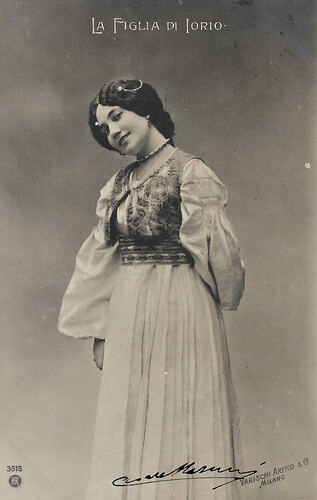
Italian postcard by RA, no. 3515. Photo: Varischi Artico & Co., Milano. Giannina Chiantoni as Ornella in 'La figlia di Jorio' (1904).
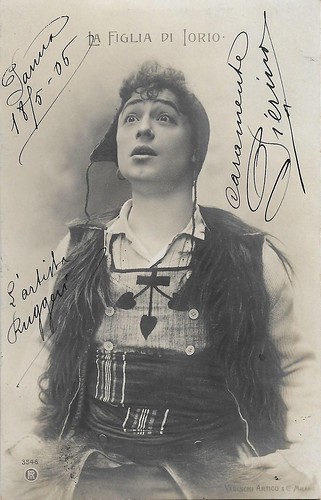
Italian postcard by RA, no. 3546. Photo: Varischi Artico.& Co., Milano. Mailed 18 May 1906. Ruggero Ruggeri as Aligi in 'La figlia di Jorio' (1904).
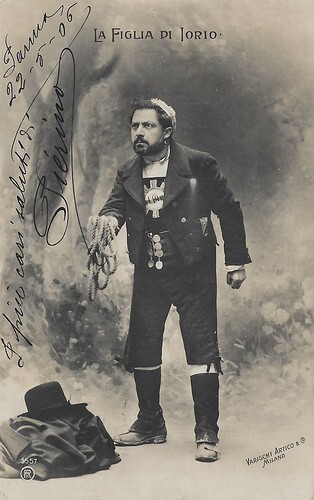
Italian postcard by RA, no. 3557. Photo: Varischi Artico & Co., Milano. Oreste Calabresi as Lazaro in 'La figlia di Jorio' ( 1904).
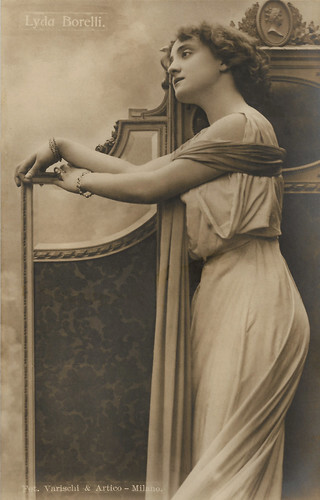
Italian postcard. Photo: Varischi & Artico, Milano. Lyda Borelli .
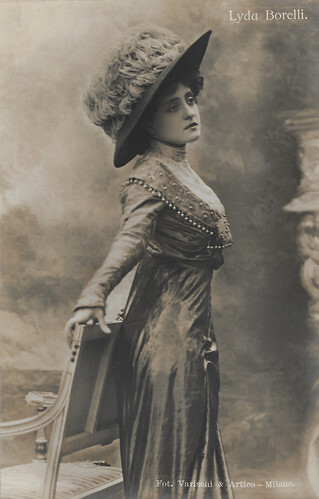
Italian postcard. Photo: Varischi & Artico, Milano. Lyda Borelli .
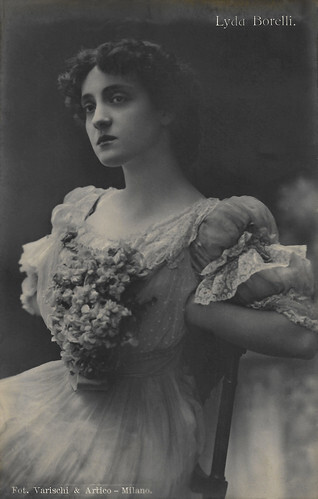
Italian postcard. Photo: Varischi & Artico, Milano. Lyda Borelli .
Daguerreotype business
In 1900, Arturo Varischi and Giovanni Artico became the owners of the portrait studio and photo laboratory of Leone Ricci in Milano, Italy, where they had both been trained.
Ricci had started his daguerreotype business already before 1850 and thus was one of the earliest photographers in Milano. His studio had a long history of portraying the Milanese bourgeoisie and aristocracy and Varischi & Artico Company continued this tradition.
Giovanni Artico was born in Vittorio Veneto in 1868. After his studies in chemistry, he established himself in Milan. Like many young contemporaries, he was interested in the upcoming business of photography. He chose to start working in the portrait studio of Leone Ricci.
There he met another employee, Arturo Varischi, and the two decided to take over Ricci's business.
The two photographers conveniently shared their business location (first Corso Vittorio Emanuele 110-111, later Corso Vittorio Emanuele 22) with Angelo Pettazzi, an established merchant and producer of photographic equipment and supplies.
Most of the photos of Varischi & Artico date from 1900-1920, while the company name was first spelt as Varischi, Artico & Co., and later on as Varischi & Artico Co. On postcards, the credit reads Fot. Varischi & Artico - Milano - as on the postcard above.
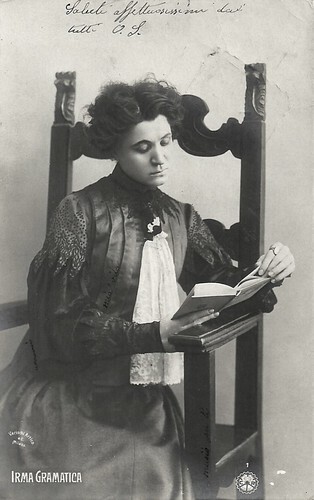
Italian postcard by TCR, no. 1. Photo: Varischi Artico & Co., Milano. Irma Gramatica.
Irma Gramatica (1867-1962) was an Italian stage and screen actress, known for her talent but also for her temper.
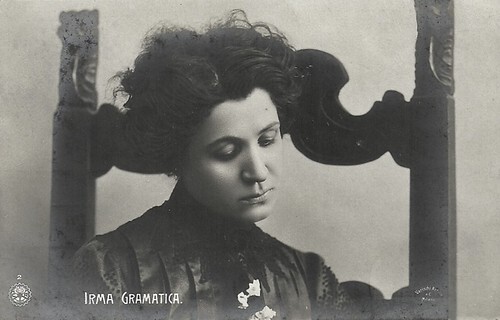
Italian postcard by TCR, no. 2. Photo: Varischi Artico & Co., Milano. Irma Gramatica.
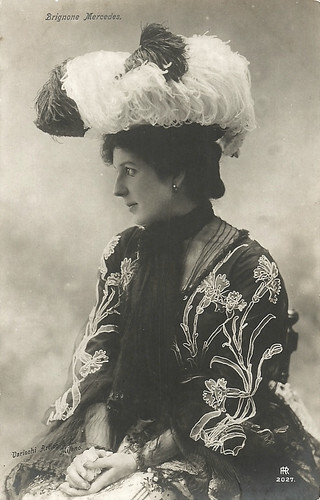
Italian postcard by RA, no. 2027. Photo: Varischi Artico e C., Milano. Mercedes Brignone .
Mercedes Brignone (1885-1967) was an Italian theatre, film and television actress. She was a major star in Italian silent cinema of the 1910s and early 1920s. In the 1930s and early 1940s, she often played secondary parts in Italian sound films.
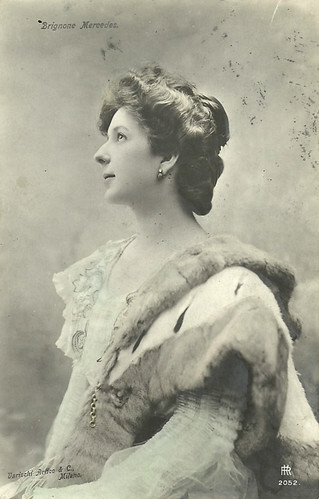
Italian postcard by RA, no. 2052. Photo: Varischi Artico & Co. Milano. Mercedes Brignone .
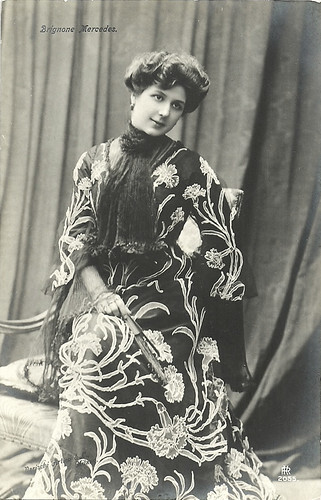
Italian postcard by AR, no. 2055. Photo: Varischi Artico e C., Milano. Mercedes Brignone .
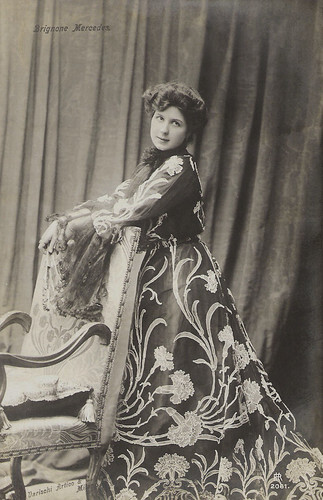
Italian postcard by RA, no. 2061. Photo: Varischi Artico & Co. Milano. Sent by mail in Belgium in 1917. Mercedes Brignone .
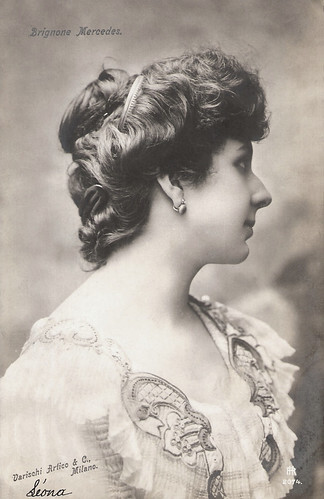
Italian postcard by RA, no. 2074. Photo: Varischi Artico & Co. Milano. Sent by mail in Belgium in 1906. Mercedes Brignone .
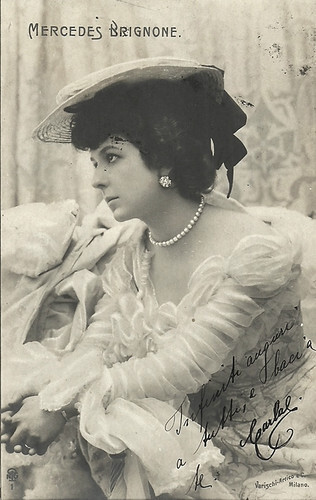
Italian postcard by NPG, no. 1. Photo: Varischi Artico e C., Milano. Mercedes Brignone .
Performers of the Scala
Arturo Varischi and Giovanni Artico soon gained a reputation for their infant portraits. They were also known for their ability in attracting famous artists to their studio. Renowned opera performers from the Scala flocked to Varischi & Artico Co. for their publicity by use of souvenir photographs and picture postcards.
They also attracted famous musicians like Arturo Toscanini, stage actors and writers to their studio. Soon also the first film stars were portrayed by them. One of their most popular subjects was the first diva of the silent Italian cinema, Lyda Borelli. Notable is also their series of colour portraits.
Arturo Varischi died prematurely. In 1923 Artico took over on his own and transformed the 19th-century portrait studio into a modern business.
Giovanni Artico died in 1930, and his widow, Regina Trelancia, continued the activities till 1933. Later their son Carlo Artico also became a photographer and reopened Studio Artico in Milan.
In the archive of Studio Artico, there are about 70 original photos of famous personalities like author Giovanni Verga and actress Tina de Lorenzo, which were signed by the sitters. They show the artistry and craftsmanship of Artico. Many prints of his work can be found in archives all over Italy, especially in Milan.
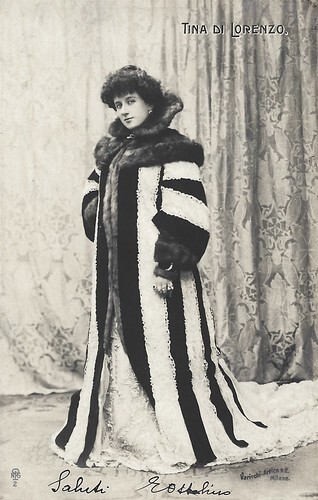
Italian postcard by NPG, no. 2. Photo: Varischi Artico & C., Milano. Tina Di Lorenzo.
Tina Di Lorenzo (1872-1930) was one of the 'grand dames' of the Italian stage during the early twentieth century, nicknamed "Angelicata" and "La encantadora". In 1915 she also acted in two or three films. In 1901 she married reputed stage actor Armando Falconi, who would have a second career in Italian sound cinema.
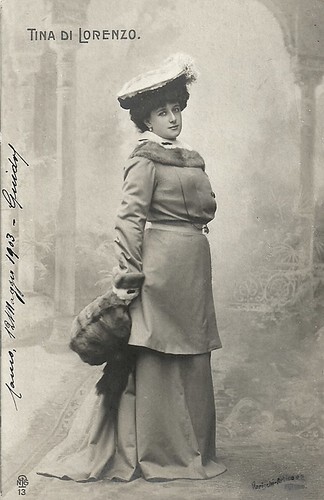
Italian postcard by NPG, no. 13. Photo: Varischi Artico & C., Milano. Sent by mail on 12 May 1903. Tina Di Lorenzo.
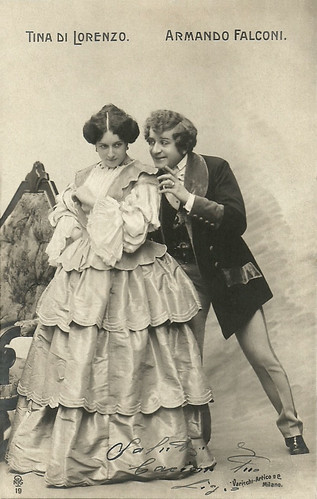
Italian postcard by NPG, no. 19. Photo: Varischi Artico & C., Milano. Armando Falconi and Tina Di Lorenzo.
Armando Falconi (1871-1954) was an Italian stage and screen actor. Though he was foremost a theatre actor and comedian, he had a prolific career as a comedian in Italian cinema of the 1930s and early 1940s. He was married to the famous stage actress Tina Di Lorenzo, with whom he also often acted together.
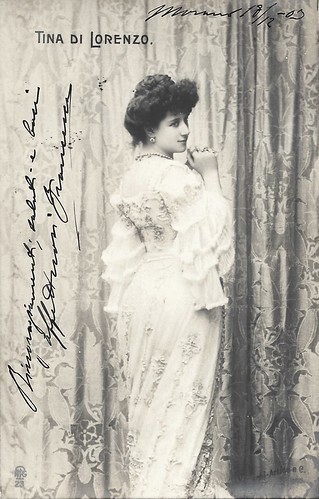
Italian postcard by NPG, no. 23. Photo: Varischi Artico & C., Milano. Sent by mail on 18-12-1903. Tina Di Lorenzo.
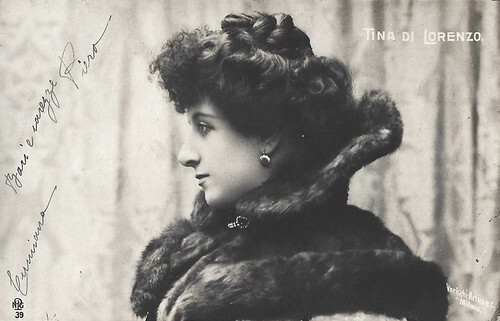
Italian postcard by NPG, no. 39. Photo: Varischi Artico & C., Milano. Tina Di Lorenzo.
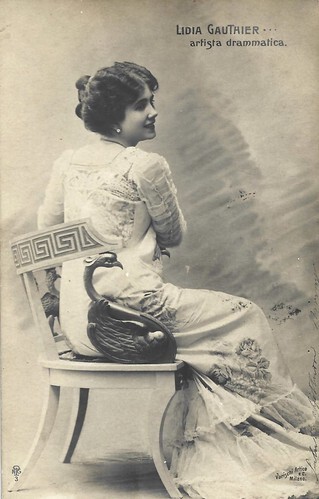
Italian postcard by NPG, no. 3. Photo: Varischi Artico & C., Milano.
Lidia Gauthier (?-?) is a little-known Italian stage actress who in the 1900s though knew a certain reputation and was portrayed by photo studios such as Varischi Artico. She acted e.g. at the stage company of Teresa Mariani, where Gianna Chiantoni was the leading actress.
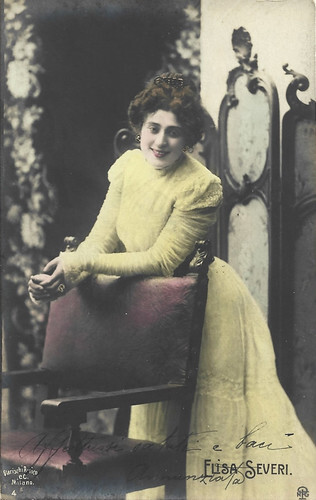
Italian postcard by NPG, no. 4. Photo: Varischi Artico & C., Milano.
Elisa Severi (1872-1930) started as a stage actress. She joined the Drammatica Compagnia Palladini-Talli in 1894, and headed a company with Oreste Calabresi for the 1905-1906 season, with Mercedes Brignone as one of the company's other actresses. Severi appeared in twenty silent films between 1913 and 1921. She was the grandmother of the famous film director Mario Monicelli.
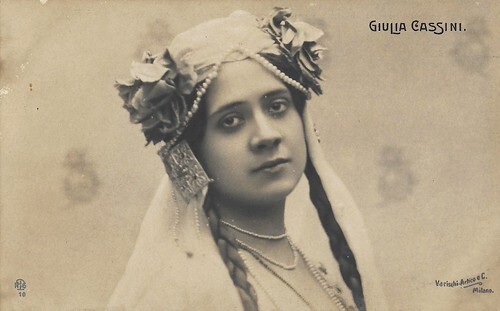
Italian postcard by NPG, no. 10. Photo: Varischi Artico & C., Milano.
Giulia Cassini Rizzotto (1865-1943) was an Italian actress and film director, kindergarten teacher, novelist, translator and writer. She appeared in many films in Italy including Malombra (1917) and Fabiola (1918) and directed five films herself. She was married to the actor Alfonso Cassini.
Sources: Giovanna Ginex (Varischi e Artico fotografi a Milano: i primi decenni del secolo), Silvia Paoli (Lo studio e laboratorio fotografico Artico, Rivista di storia e fotografia, no. 24, II, december 1996), Max Hochstetler (Luminous Lint), and Claudia Morgan (Commune di Trieste) (Italian).

Italian postcard. Photo: Varischi & Artico. Lyda Borelli .
Lyda Borelli (1887-1959) was already an acclaimed stage actress before she became the first diva of Italian silent cinema. The fascinating film star caused a craze among female fans called 'Borellismo'.

Italian postcard by RA, no. 2015. Photo: Varischi Artico & Co., Milano. Lyda Borelli .

Italian postcard by RA, no. 2023. Photo: Varischi Artico & Co, Milano. Lyda Borelli .

Italian postcard by RA, no. 2125. Photo: Varischi Artico & Co., Milano. Lyda Borelli .

Italian postcard by RA, no. 2120. Photo: Varischi Artico & Co, Milano. Lyda Borelli and Giannina Chiantoni in Gabriele D'Annunzio's stage play 'La figlia di Jorio' (1904)

Italian postcard by RA, no. 2152. Photo: Varischi Artico Co., Milano. Lyda Borelli as Favetta in the stage play 'La figlia di Jorio' by Gabriele D'Annunzio (1904).
In 1903, Gabriele D'Annunzio wrote the drama 'La figlia di Jorio' (The Daughter of Jorio), a pastoral tragedy situated in the Abruzzi mountains in the centre of Italy. On 2 March 1904, the stage company Talli-Calabresi-Grammatica performed the premiere of the play at the Teatro Lirico in Milan. The protagonist should have been Eleonora Duse , but she fell ill. D' Annunzio, whose relationship with Duse was fading, didn't wait for her healing and gave the female lead to Irma Grammatica - which hurt Duse dearly. The painter Francesco Paolo Michetti, a good friend of D'Annunzio, designed the sets and costumes. The play was a huge success, also in Chieti in Abruzzi when it was performed there the same year. In 1907, with D'Annunzio's permission, a version in the Abruzzi dialect was written and performed.

Italian postcard by RA, no. 3515. Photo: Varischi Artico & Co., Milano. Giannina Chiantoni as Ornella in 'La figlia di Jorio' (1904).

Italian postcard by RA, no. 3546. Photo: Varischi Artico.& Co., Milano. Mailed 18 May 1906. Ruggero Ruggeri as Aligi in 'La figlia di Jorio' (1904).

Italian postcard by RA, no. 3557. Photo: Varischi Artico & Co., Milano. Oreste Calabresi as Lazaro in 'La figlia di Jorio' ( 1904).

Italian postcard. Photo: Varischi & Artico, Milano. Lyda Borelli .

Italian postcard. Photo: Varischi & Artico, Milano. Lyda Borelli .

Italian postcard. Photo: Varischi & Artico, Milano. Lyda Borelli .
Daguerreotype business
In 1900, Arturo Varischi and Giovanni Artico became the owners of the portrait studio and photo laboratory of Leone Ricci in Milano, Italy, where they had both been trained.
Ricci had started his daguerreotype business already before 1850 and thus was one of the earliest photographers in Milano. His studio had a long history of portraying the Milanese bourgeoisie and aristocracy and Varischi & Artico Company continued this tradition.
Giovanni Artico was born in Vittorio Veneto in 1868. After his studies in chemistry, he established himself in Milan. Like many young contemporaries, he was interested in the upcoming business of photography. He chose to start working in the portrait studio of Leone Ricci.
There he met another employee, Arturo Varischi, and the two decided to take over Ricci's business.
The two photographers conveniently shared their business location (first Corso Vittorio Emanuele 110-111, later Corso Vittorio Emanuele 22) with Angelo Pettazzi, an established merchant and producer of photographic equipment and supplies.
Most of the photos of Varischi & Artico date from 1900-1920, while the company name was first spelt as Varischi, Artico & Co., and later on as Varischi & Artico Co. On postcards, the credit reads Fot. Varischi & Artico - Milano - as on the postcard above.

Italian postcard by TCR, no. 1. Photo: Varischi Artico & Co., Milano. Irma Gramatica.
Irma Gramatica (1867-1962) was an Italian stage and screen actress, known for her talent but also for her temper.

Italian postcard by TCR, no. 2. Photo: Varischi Artico & Co., Milano. Irma Gramatica.

Italian postcard by RA, no. 2027. Photo: Varischi Artico e C., Milano. Mercedes Brignone .
Mercedes Brignone (1885-1967) was an Italian theatre, film and television actress. She was a major star in Italian silent cinema of the 1910s and early 1920s. In the 1930s and early 1940s, she often played secondary parts in Italian sound films.

Italian postcard by RA, no. 2052. Photo: Varischi Artico & Co. Milano. Mercedes Brignone .

Italian postcard by AR, no. 2055. Photo: Varischi Artico e C., Milano. Mercedes Brignone .

Italian postcard by RA, no. 2061. Photo: Varischi Artico & Co. Milano. Sent by mail in Belgium in 1917. Mercedes Brignone .

Italian postcard by RA, no. 2074. Photo: Varischi Artico & Co. Milano. Sent by mail in Belgium in 1906. Mercedes Brignone .

Italian postcard by NPG, no. 1. Photo: Varischi Artico e C., Milano. Mercedes Brignone .
Performers of the Scala
Arturo Varischi and Giovanni Artico soon gained a reputation for their infant portraits. They were also known for their ability in attracting famous artists to their studio. Renowned opera performers from the Scala flocked to Varischi & Artico Co. for their publicity by use of souvenir photographs and picture postcards.
They also attracted famous musicians like Arturo Toscanini, stage actors and writers to their studio. Soon also the first film stars were portrayed by them. One of their most popular subjects was the first diva of the silent Italian cinema, Lyda Borelli. Notable is also their series of colour portraits.
Arturo Varischi died prematurely. In 1923 Artico took over on his own and transformed the 19th-century portrait studio into a modern business.
Giovanni Artico died in 1930, and his widow, Regina Trelancia, continued the activities till 1933. Later their son Carlo Artico also became a photographer and reopened Studio Artico in Milan.
In the archive of Studio Artico, there are about 70 original photos of famous personalities like author Giovanni Verga and actress Tina de Lorenzo, which were signed by the sitters. They show the artistry and craftsmanship of Artico. Many prints of his work can be found in archives all over Italy, especially in Milan.

Italian postcard by NPG, no. 2. Photo: Varischi Artico & C., Milano. Tina Di Lorenzo.
Tina Di Lorenzo (1872-1930) was one of the 'grand dames' of the Italian stage during the early twentieth century, nicknamed "Angelicata" and "La encantadora". In 1915 she also acted in two or three films. In 1901 she married reputed stage actor Armando Falconi, who would have a second career in Italian sound cinema.

Italian postcard by NPG, no. 13. Photo: Varischi Artico & C., Milano. Sent by mail on 12 May 1903. Tina Di Lorenzo.

Italian postcard by NPG, no. 19. Photo: Varischi Artico & C., Milano. Armando Falconi and Tina Di Lorenzo.
Armando Falconi (1871-1954) was an Italian stage and screen actor. Though he was foremost a theatre actor and comedian, he had a prolific career as a comedian in Italian cinema of the 1930s and early 1940s. He was married to the famous stage actress Tina Di Lorenzo, with whom he also often acted together.

Italian postcard by NPG, no. 23. Photo: Varischi Artico & C., Milano. Sent by mail on 18-12-1903. Tina Di Lorenzo.

Italian postcard by NPG, no. 39. Photo: Varischi Artico & C., Milano. Tina Di Lorenzo.

Italian postcard by NPG, no. 3. Photo: Varischi Artico & C., Milano.
Lidia Gauthier (?-?) is a little-known Italian stage actress who in the 1900s though knew a certain reputation and was portrayed by photo studios such as Varischi Artico. She acted e.g. at the stage company of Teresa Mariani, where Gianna Chiantoni was the leading actress.

Italian postcard by NPG, no. 4. Photo: Varischi Artico & C., Milano.
Elisa Severi (1872-1930) started as a stage actress. She joined the Drammatica Compagnia Palladini-Talli in 1894, and headed a company with Oreste Calabresi for the 1905-1906 season, with Mercedes Brignone as one of the company's other actresses. Severi appeared in twenty silent films between 1913 and 1921. She was the grandmother of the famous film director Mario Monicelli.

Italian postcard by NPG, no. 10. Photo: Varischi Artico & C., Milano.
Giulia Cassini Rizzotto (1865-1943) was an Italian actress and film director, kindergarten teacher, novelist, translator and writer. She appeared in many films in Italy including Malombra (1917) and Fabiola (1918) and directed five films herself. She was married to the actor Alfonso Cassini.
Sources: Giovanna Ginex (Varischi e Artico fotografi a Milano: i primi decenni del secolo), Silvia Paoli (Lo studio e laboratorio fotografico Artico, Rivista di storia e fotografia, no. 24, II, december 1996), Max Hochstetler (Luminous Lint), and Claudia Morgan (Commune di Trieste) (Italian).
Published on June 06, 2023 22:00
June 5, 2023
La Collectionneuse: Nita Naldi
With her exotic looks, Nita Naldi was one of the most famous Hollywood vamps of the 1920s. She notably co-starred with Rudolph Valentino in three movies. Interestingly enough, she also had a leading role in an early Alfred Hitchcock film. About her career, she once wittily declared: "They had ermine tails and paradises in my hair and a couple of snakes coiled around my neck. In real life, believe me, any man of sensibilities would have run 20 miles to get out of my sight".

German postcard by Ross Verlag, no. 4686/1, 1929-1930. Photo: Paramount Pictures. Nita Naldi and Rudolph Valentino in Blood and Sand (Fred Niblo, 1922).

Spanish postcard by Ediciones Adolfo Zerkowitz, Barcelona, no. C-70. Photo: Paramount.

Italian postcard by Casa Editrice Ballerini & Fratini (B.F.F. Edit.), no. 119. Photo: Films Paramount. Nita Naldi in The Ten Commandments (Cecil B. De Mille, 1923).

Italian postcard by Casa Editrice Ballerini & Fratini (B.F.F. Edit.), no. 120. Photo: Films Paramount. Nita Naldi in The Ten Commandments (Cecil B. De Mille, 1923).

British postcard in the Famous Cinema Stars Series by Beagles, no. 101 U. Photo: Paramount.
Nita Naldi on stage
Nita Naldi was born Mary Nonna Dooley on the 13th of November 1894 in New York, U.S.A.
Several years after her father had left the family, her mother passed away in 1915.
She soon turned to the stage and her first known Broadway credit was in 'Follow the Girl' in 1918.
She also appeared, e.g., in 'The Passing Show of 1918', a lavish revue produced by the famous Lee and Jacob J. Shubert.

American AZO postcard.

Swedish postcard by Ljunggrens Konstförlag, Stockholm, no. 193.

German postcard by Ross Verlag, no. 873/4, 1925-1926. Photo: Paramount.

Croatian postcard by Edit. Caklovic, Zagreb, no. 76. Photo: Bosna-Film.

Mexican postcard by CIE, no. 1322.
Her first steps in movies
The movie industry took interest in her and she was noticed as dancer Gina, a victim of the sinister Mr. Hyde, in Dr Jekyll and Mr. Hyde (1920), opposite John Barrymore .
Although of Irish descent, Nita Naldi had a type of beauty which mixed Latin and oriental features that gave an exotic flavour to her screen persona and prevented her to play wholesome All-American girls.
As a result, she quickly became typecast.
For example, she is a vamp whose extravagant demands cause her victim to forge a check in Life (1921), a malevolent mistress in The Common Sin (1920), a Spanish coquette in A Divorce of Convenience (1921), a money-hungry revue dancer in Channing of the Northwest (1922) and appropriately plays a character called Temptation in the allegory film Experience (1921).

Italian postcard.

Swedish postcard by Ljunggrens Konstförlag, Stockholm, no. 194.

British postcard by Picturegoer, no. 142. Photo: Paramount.

Danish postcard by J. Chr. Olsens Kunstforlag, Eneret, no. 656.

Romanian postcard.
Paramount’s no. 1 vamp
She got her big break when she was chosen to play man-eater Dona Sol in Blood and Sand (1922), opposite Rudolph Valentino. Her success prompted Paramount to sign her and she became their no. 1 vamp.
She played the role to the hilt: she is, notably, Countess Rostoff, an international thief, in Anna Ascends (1922), a vampy owner of a crooked gambling house who financially ruins Hope Hampton’s husband in Lawful Larceny (1923), a surgeon’s wife who seduces Lewis Stone , although he’s married to Leatrice Joy, in You Can’t Fool Your Wife (1923), a promiscuous opera diva who adds Jack Holt to her list of conquests, much to the chagrin of Agnes Ayres who sincerely loves him, in Don’t Call it Love (1923) and an actress with whom Matt Moore is infatuated with, which provokes her husband’s jealousy, in The Breaking Point (1924).
In Cecil B. DeMille ’s The Ten Commandments (1923), she plays evil Eurasian Sally Lung and her death scene especially stood out.To her lover who, in need of money, had pressed her for the return of a set of expensive pearls he had bought her, she nixes the idea by answering "Poor Sally would catch a cold without her pearls". After realizing that he won’t get anything from her, he takes the necklace by force and declares he’s through with her. She retaliates by telling him she’s a leper and that he most probably got the disease from her. Horrified, he shoots her and she utters, before expiring, "Danny dear, I’ll tell the devil you won’t be far behind", which proves prophetic as he soon dies in a fatal boat accident.
In March 1923, a beautiful portrait of her posing with a faun by Alberto Vargas was published in Shadowland. For the magazine, the artist added clothing on her left breast, which, in the original drawing, was naked.
Over the years, recurrent remarks in the press about her weight somewhat hampered her career and reviewers were not always subtle when discussing her girth.Her Paramount contract ended with A Sainted Devil (1924), as Carlotta, Rudolph Valentino ’s jealous former girlfriend.

Swedish postcard by Ljunggrens Konstförlag, Stockholm, no. 115.

Spanish postcard by La Novela Grafica, no. 14.

Swedish postcard by Forlag Nordisk Konst, Stockholm, no. 1256.

Italian postcard. Nita Naldi in A Sainted Devil (Joseph Henabery, 1924).

French postcard by Europe, no. 197. Photo: United Artists Corporation, New York. Nita Naldi and Rudolph Valentino in Cobra (Joseph Henabery, 1925)
Last Hollywood films and Nita Naldi in Europe
She soon reteamed with Valentino in her third and final film with him, Cobra (1925), as ambitious and unscrupulous Elise Van Zile.
In What Price Beauty, produced by Valentino’s wife, Natacha Rambova, she is Rita Rinaldi, a vamp who competes with country girl Mary for the love of a man. This movie was made in 1925 but was only distributed in 1928.
Among Nita Naldi‘s last Hollywood roles were Toinette, a cabaret dancer with whom Corinne Griffith ’s husband has an affair, in The Marriage Whirl (1925), Fifi, who is the reason why Virginia Valli breaks her engagement to Lewis Stone , in The Lady Who Lied (1925) and Blanchita d’Acosta, a revue star who entices Hope Hampton’s fiancé in The Unfair Sex (1926). She also appeared in Clothes Make the Pirate (1925) a Leon Errol comedy.
In 1926, she left for Europe, where she played the unusual role of a schoolteacher in the Anglo-German co-production The Mountain Eagle/Der Bergadler (1926), directed by Alfred Hitchcock .
She also went to France for La femme nue (1926), as the wealthy Princesse de Chabran, Louise Lagrange ’s love rival, and to Austria for Die Pratermizzi (1926), as a mysterious masked dancer who fascinates Anny Ondra ’s boyfriend. In August 1929, she married James Searle Barclay Jr., in Paris. He hailed from a wealthy Long Island family and had been her lover for several years.

American postcard by Exhibit Supply Co., Chicago. Photo: First National. Nita Naldi in The Lady Who Lied (Edwin Carewe, 1925).

French postcard in Les vedettes de cinéma series by A.N. Paris, no. 184. Photo: G.L. Manuel Frères.

Vintage postcard. Nita Naldi in La femme nue/The Model from Montmartre (Léonce Perret, 1926).

Austrian postcard by Iris Verlag, no. 626. Photo: Sascha.

Spanish postcard. Nita Naldi and Igo Sym in Die Pratermizzi/The Golden Mask (Karl Leiter, Gustav Ucicky, 1926). The Spanish title was La mascara de oro.
Harder times
Nita and her husband returned permanently to the U.S.A. in 1931 and, in 1932, she made her comeback on Broadway in a short-lived play starring Judith Anderson, 'Firebird'.
But her easy life was coming to an end: Nita Naldi and James Searle Barclay’s finances went downhill and she filed for bankruptcy in 1933. The couple had never been frugal in their expenses and Barclay’s wealth had melted away because of the Great Depression.
Afterwards, she occasionally went back to the stage and, in 1941, she was hired by Billy Rose to appear in his colourful Billy Rose Diamond Horseshoe Revue - The Silver Screen, in which she shared the bill with other old-timers such as Mae Murray , Gilda Gray and Carlyle Blackwell. She was widowed in 1945 and no probate was filed, as her husband had left so little money.
In 1952, she made her last appearance on Broadway as Marquesa Del Veccio Sporenza, a middle-aged woman fond of gigolos, in 'In Any Language', starring Uta Hagen. She could also be seen in several TV shows, such as The Robert Q. Lewis Show in 1950 or Jack Paar’s Tonight Show in 1958. On the 10th of March 1956, Nita, alongside the Gish Sisters, Leatrice Joy and Lila Lee, reminisced about the silent movie days on the CBS radio program 'Make up Your Mind'. In public, she always took care to maintain the old Nita Naldi image with jet-black hair, khôl-rimmed eyes, painted lips and long manicured nails.
During the last years of her life, the Actor’s Fund partially paid the rent of her room at the Wentworth Hotel in New York and she was plagued with health and sight problems. But she didn’t complain and kept her wit and her sense of humour. She passed away on the 17th of February 1961.
Text and postcards: Marlene Pilaete.

German postcard by Ross Verlag, no. 4686/1, 1929-1930. Photo: Paramount Pictures. Nita Naldi and Rudolph Valentino in Blood and Sand (Fred Niblo, 1922).

Spanish postcard by Ediciones Adolfo Zerkowitz, Barcelona, no. C-70. Photo: Paramount.

Italian postcard by Casa Editrice Ballerini & Fratini (B.F.F. Edit.), no. 119. Photo: Films Paramount. Nita Naldi in The Ten Commandments (Cecil B. De Mille, 1923).

Italian postcard by Casa Editrice Ballerini & Fratini (B.F.F. Edit.), no. 120. Photo: Films Paramount. Nita Naldi in The Ten Commandments (Cecil B. De Mille, 1923).

British postcard in the Famous Cinema Stars Series by Beagles, no. 101 U. Photo: Paramount.
Nita Naldi on stage
Nita Naldi was born Mary Nonna Dooley on the 13th of November 1894 in New York, U.S.A.
Several years after her father had left the family, her mother passed away in 1915.
She soon turned to the stage and her first known Broadway credit was in 'Follow the Girl' in 1918.
She also appeared, e.g., in 'The Passing Show of 1918', a lavish revue produced by the famous Lee and Jacob J. Shubert.

American AZO postcard.

Swedish postcard by Ljunggrens Konstförlag, Stockholm, no. 193.

German postcard by Ross Verlag, no. 873/4, 1925-1926. Photo: Paramount.

Croatian postcard by Edit. Caklovic, Zagreb, no. 76. Photo: Bosna-Film.

Mexican postcard by CIE, no. 1322.
Her first steps in movies
The movie industry took interest in her and she was noticed as dancer Gina, a victim of the sinister Mr. Hyde, in Dr Jekyll and Mr. Hyde (1920), opposite John Barrymore .
Although of Irish descent, Nita Naldi had a type of beauty which mixed Latin and oriental features that gave an exotic flavour to her screen persona and prevented her to play wholesome All-American girls.
As a result, she quickly became typecast.
For example, she is a vamp whose extravagant demands cause her victim to forge a check in Life (1921), a malevolent mistress in The Common Sin (1920), a Spanish coquette in A Divorce of Convenience (1921), a money-hungry revue dancer in Channing of the Northwest (1922) and appropriately plays a character called Temptation in the allegory film Experience (1921).

Italian postcard.

Swedish postcard by Ljunggrens Konstförlag, Stockholm, no. 194.

British postcard by Picturegoer, no. 142. Photo: Paramount.

Danish postcard by J. Chr. Olsens Kunstforlag, Eneret, no. 656.

Romanian postcard.
Paramount’s no. 1 vamp
She got her big break when she was chosen to play man-eater Dona Sol in Blood and Sand (1922), opposite Rudolph Valentino. Her success prompted Paramount to sign her and she became their no. 1 vamp.
She played the role to the hilt: she is, notably, Countess Rostoff, an international thief, in Anna Ascends (1922), a vampy owner of a crooked gambling house who financially ruins Hope Hampton’s husband in Lawful Larceny (1923), a surgeon’s wife who seduces Lewis Stone , although he’s married to Leatrice Joy, in You Can’t Fool Your Wife (1923), a promiscuous opera diva who adds Jack Holt to her list of conquests, much to the chagrin of Agnes Ayres who sincerely loves him, in Don’t Call it Love (1923) and an actress with whom Matt Moore is infatuated with, which provokes her husband’s jealousy, in The Breaking Point (1924).
In Cecil B. DeMille ’s The Ten Commandments (1923), she plays evil Eurasian Sally Lung and her death scene especially stood out.To her lover who, in need of money, had pressed her for the return of a set of expensive pearls he had bought her, she nixes the idea by answering "Poor Sally would catch a cold without her pearls". After realizing that he won’t get anything from her, he takes the necklace by force and declares he’s through with her. She retaliates by telling him she’s a leper and that he most probably got the disease from her. Horrified, he shoots her and she utters, before expiring, "Danny dear, I’ll tell the devil you won’t be far behind", which proves prophetic as he soon dies in a fatal boat accident.
In March 1923, a beautiful portrait of her posing with a faun by Alberto Vargas was published in Shadowland. For the magazine, the artist added clothing on her left breast, which, in the original drawing, was naked.
Over the years, recurrent remarks in the press about her weight somewhat hampered her career and reviewers were not always subtle when discussing her girth.Her Paramount contract ended with A Sainted Devil (1924), as Carlotta, Rudolph Valentino ’s jealous former girlfriend.

Swedish postcard by Ljunggrens Konstförlag, Stockholm, no. 115.

Spanish postcard by La Novela Grafica, no. 14.

Swedish postcard by Forlag Nordisk Konst, Stockholm, no. 1256.

Italian postcard. Nita Naldi in A Sainted Devil (Joseph Henabery, 1924).

French postcard by Europe, no. 197. Photo: United Artists Corporation, New York. Nita Naldi and Rudolph Valentino in Cobra (Joseph Henabery, 1925)
Last Hollywood films and Nita Naldi in Europe
She soon reteamed with Valentino in her third and final film with him, Cobra (1925), as ambitious and unscrupulous Elise Van Zile.
In What Price Beauty, produced by Valentino’s wife, Natacha Rambova, she is Rita Rinaldi, a vamp who competes with country girl Mary for the love of a man. This movie was made in 1925 but was only distributed in 1928.
Among Nita Naldi‘s last Hollywood roles were Toinette, a cabaret dancer with whom Corinne Griffith ’s husband has an affair, in The Marriage Whirl (1925), Fifi, who is the reason why Virginia Valli breaks her engagement to Lewis Stone , in The Lady Who Lied (1925) and Blanchita d’Acosta, a revue star who entices Hope Hampton’s fiancé in The Unfair Sex (1926). She also appeared in Clothes Make the Pirate (1925) a Leon Errol comedy.
In 1926, she left for Europe, where she played the unusual role of a schoolteacher in the Anglo-German co-production The Mountain Eagle/Der Bergadler (1926), directed by Alfred Hitchcock .
She also went to France for La femme nue (1926), as the wealthy Princesse de Chabran, Louise Lagrange ’s love rival, and to Austria for Die Pratermizzi (1926), as a mysterious masked dancer who fascinates Anny Ondra ’s boyfriend. In August 1929, she married James Searle Barclay Jr., in Paris. He hailed from a wealthy Long Island family and had been her lover for several years.

American postcard by Exhibit Supply Co., Chicago. Photo: First National. Nita Naldi in The Lady Who Lied (Edwin Carewe, 1925).

French postcard in Les vedettes de cinéma series by A.N. Paris, no. 184. Photo: G.L. Manuel Frères.

Vintage postcard. Nita Naldi in La femme nue/The Model from Montmartre (Léonce Perret, 1926).

Austrian postcard by Iris Verlag, no. 626. Photo: Sascha.

Spanish postcard. Nita Naldi and Igo Sym in Die Pratermizzi/The Golden Mask (Karl Leiter, Gustav Ucicky, 1926). The Spanish title was La mascara de oro.
Harder times
Nita and her husband returned permanently to the U.S.A. in 1931 and, in 1932, she made her comeback on Broadway in a short-lived play starring Judith Anderson, 'Firebird'.
But her easy life was coming to an end: Nita Naldi and James Searle Barclay’s finances went downhill and she filed for bankruptcy in 1933. The couple had never been frugal in their expenses and Barclay’s wealth had melted away because of the Great Depression.
Afterwards, she occasionally went back to the stage and, in 1941, she was hired by Billy Rose to appear in his colourful Billy Rose Diamond Horseshoe Revue - The Silver Screen, in which she shared the bill with other old-timers such as Mae Murray , Gilda Gray and Carlyle Blackwell. She was widowed in 1945 and no probate was filed, as her husband had left so little money.
In 1952, she made her last appearance on Broadway as Marquesa Del Veccio Sporenza, a middle-aged woman fond of gigolos, in 'In Any Language', starring Uta Hagen. She could also be seen in several TV shows, such as The Robert Q. Lewis Show in 1950 or Jack Paar’s Tonight Show in 1958. On the 10th of March 1956, Nita, alongside the Gish Sisters, Leatrice Joy and Lila Lee, reminisced about the silent movie days on the CBS radio program 'Make up Your Mind'. In public, she always took care to maintain the old Nita Naldi image with jet-black hair, khôl-rimmed eyes, painted lips and long manicured nails.
During the last years of her life, the Actor’s Fund partially paid the rent of her room at the Wentworth Hotel in New York and she was plagued with health and sight problems. But she didn’t complain and kept her wit and her sense of humour. She passed away on the 17th of February 1961.
Text and postcards: Marlene Pilaete.
Published on June 05, 2023 22:00
June 4, 2023
Early Pathé Frères: Le chat botté (1908)
During the 1900s, the French company Pathé Frères was famous for its coloured-in adaptations of fairytales, mainly from the French writer Charles Perrault: Le chat botté/Puss in Boots, La belle au bois dormant/Sleeping Beauty, Le petit poucet/Tom Thumb, Barbe-bleue/Bluebird, Cendrillon/ Cinderella, Le petit chaperon rouge/Little Red Riding Hood, and Peau d'âne/Donkeyskin. Georges Méliès started these fairytale films in France before 1900 with Cendrillon (1899), while from 1910 Gaumont would also film a few fairytales.
Today and next week, we will present at EFSP the Pathé Frères versions of Le chat botté/Puss in Boots and La belle au bois dormant/Sleeping Beauty with beautiful hand-coloured cards by Croissant. Strangely enough, the third postcard of Le chat botté/Puss in Boots (Albert Capellani, 1908) refers to another film version, Le Chat botté/Puss in Boots (Lucien Nonguet, 1903). Both film versions still exist and can be viewed on Youtube: Le chat botté/Puss in Boots (Lucien Nonguet, 1903) and Le chat botté/Puss in Boots (Albert Capellani, 1908). In the 1908 version, the miller's son, later the Marquis of Carabas, is played by a woman.

French postcard by Croissant, Paris, no. 3667. Photo: Film Pathé. Scene from Le Chat botté/Puss in Boots (Albert Capellani, 1908), based on the fairytale by Charles Perrault (1697). Caption: A miller had three sons.

French postcard by Croissant, Paris, no. 3667. Photo: Film Pathé. Scene from Le Chat botté/Puss in Boots (Albert Capellani, 1908). Caption: The youngest only inherited the cat.

French postcard by Croissant, Paris, no. 3667. Photo: Film Pathé. Scene from Le Chat botté/Puss in Boots (Lucien Nonguet, 1903) with Bretteau and Edmond Boutillon. Caption: The King rescuing the Marquis of Carabas.
A craving for real exteriors
The first Pathé adaptation of Le chat botté was done in 1903 by Lucien Nonguet (some sources write: in collaboration with Ferdinand Zecca). The actor Bretteau played the cat, while Edmond Boutillon was also acting in the film (the miller's son?). The film appeared in Pathé 9th series of Féerie & Contes. It had seven 'tableaux': 1. Dividing the Inheritance. The Father's death. 2. Puss in Boots consoles his master. 3. The cat goes hunting. 4. Sham drowning. 5. Visit to the Marquis of Carabas's estate. 6. The Ogres castle, the cat surprises him. 7. Betrothed. Apotheosis.
The film opens with a remarkably deep space of the "outdoor" (studio) setting of the miller's house, with real chicken added. Not only the cat but also the rabbits caught by the cat, the ghosts called up by the ogre, and the ogre changed into a lion, were all played by adult or child actors. At the ogre's castle, some gruesome moments of children being sacrificed are shown, while trapdoors open to show the ghosts of the murdered. The sets were by Vincent Lorant-Heilbronn, while some of the takes were really long.
The colouring of the film happened at the lab of Segundo De Chomon in Barcelona. A print of the film was restored by the Cinemateca de Catalunya. In contrast to other fairytale films, the almost obligatory dance scene takes place, not at the end but halfway through the plot, after the 'Marquis' is saved and the cat has instigated the farmers to praise the marquis in the presence of the King. A farmers' dance follows. The film ends with an apotheosis of a kind of audience given by the king and the young couple at the top of a grand staircase (many people attend), with children mounting the stairs.
In 1908 the second version by Albert Capellani was made. Here the actors are unknown, but what the viewer strikes is that young miller's son (and later on the marquis) is played by a woman. She, therefore, doesn't strip off all of her clothes during the fake drowning and even keeps her wig on. Also, at the ogre's castle, we see a real lion conjured up by the ogre, while the film alternated the interiors in the studio with some remarkable real outdoor images of e.g. the mill, the drowning scene in the woods, and the locals in the fields praising the Marquis of Carabas (on the instigation of the cat), contrasting with the flat backgrounds of the 1903 version, all shot in the studio.
Indeed, this craving for real exteriors happens more often in the fairytale films by Capellani, using e.g. the castle of Pierrefonds for his version of La belle au bois dormant. At the end of Capellani's Le chat botté, an element of deep staging is added when a curtain in the castle opens where the royal guests have their banquet in the back. In the last shot, the apotheosis: after a dance scene (common in fairytale films), the cat is honoured with a medal. The film was restored by Eye Filmmuseum in Amsterdam.

French postcard by Croissant, Paris, no. 3667. Photo: Film Pathé. Scene from Le Chat botté/Puss in Boots (Albert Capellani, 1908). Caption: Long live the Marquis of Carabas!

French postcard by Croissant, Paris, no. 3667. Photo: Film Pathé. Scene from Le Chat botté/Puss in Boots (Albert Capellani, 1908). Caption: Caption: He married the princess.
See also Fondation Jerome Seydoux-Pathé, which lists the same five postcards we have in our collection.
Today and next week, we will present at EFSP the Pathé Frères versions of Le chat botté/Puss in Boots and La belle au bois dormant/Sleeping Beauty with beautiful hand-coloured cards by Croissant. Strangely enough, the third postcard of Le chat botté/Puss in Boots (Albert Capellani, 1908) refers to another film version, Le Chat botté/Puss in Boots (Lucien Nonguet, 1903). Both film versions still exist and can be viewed on Youtube: Le chat botté/Puss in Boots (Lucien Nonguet, 1903) and Le chat botté/Puss in Boots (Albert Capellani, 1908). In the 1908 version, the miller's son, later the Marquis of Carabas, is played by a woman.

French postcard by Croissant, Paris, no. 3667. Photo: Film Pathé. Scene from Le Chat botté/Puss in Boots (Albert Capellani, 1908), based on the fairytale by Charles Perrault (1697). Caption: A miller had three sons.

French postcard by Croissant, Paris, no. 3667. Photo: Film Pathé. Scene from Le Chat botté/Puss in Boots (Albert Capellani, 1908). Caption: The youngest only inherited the cat.

French postcard by Croissant, Paris, no. 3667. Photo: Film Pathé. Scene from Le Chat botté/Puss in Boots (Lucien Nonguet, 1903) with Bretteau and Edmond Boutillon. Caption: The King rescuing the Marquis of Carabas.
A craving for real exteriors
The first Pathé adaptation of Le chat botté was done in 1903 by Lucien Nonguet (some sources write: in collaboration with Ferdinand Zecca). The actor Bretteau played the cat, while Edmond Boutillon was also acting in the film (the miller's son?). The film appeared in Pathé 9th series of Féerie & Contes. It had seven 'tableaux': 1. Dividing the Inheritance. The Father's death. 2. Puss in Boots consoles his master. 3. The cat goes hunting. 4. Sham drowning. 5. Visit to the Marquis of Carabas's estate. 6. The Ogres castle, the cat surprises him. 7. Betrothed. Apotheosis.
The film opens with a remarkably deep space of the "outdoor" (studio) setting of the miller's house, with real chicken added. Not only the cat but also the rabbits caught by the cat, the ghosts called up by the ogre, and the ogre changed into a lion, were all played by adult or child actors. At the ogre's castle, some gruesome moments of children being sacrificed are shown, while trapdoors open to show the ghosts of the murdered. The sets were by Vincent Lorant-Heilbronn, while some of the takes were really long.
The colouring of the film happened at the lab of Segundo De Chomon in Barcelona. A print of the film was restored by the Cinemateca de Catalunya. In contrast to other fairytale films, the almost obligatory dance scene takes place, not at the end but halfway through the plot, after the 'Marquis' is saved and the cat has instigated the farmers to praise the marquis in the presence of the King. A farmers' dance follows. The film ends with an apotheosis of a kind of audience given by the king and the young couple at the top of a grand staircase (many people attend), with children mounting the stairs.
In 1908 the second version by Albert Capellani was made. Here the actors are unknown, but what the viewer strikes is that young miller's son (and later on the marquis) is played by a woman. She, therefore, doesn't strip off all of her clothes during the fake drowning and even keeps her wig on. Also, at the ogre's castle, we see a real lion conjured up by the ogre, while the film alternated the interiors in the studio with some remarkable real outdoor images of e.g. the mill, the drowning scene in the woods, and the locals in the fields praising the Marquis of Carabas (on the instigation of the cat), contrasting with the flat backgrounds of the 1903 version, all shot in the studio.
Indeed, this craving for real exteriors happens more often in the fairytale films by Capellani, using e.g. the castle of Pierrefonds for his version of La belle au bois dormant. At the end of Capellani's Le chat botté, an element of deep staging is added when a curtain in the castle opens where the royal guests have their banquet in the back. In the last shot, the apotheosis: after a dance scene (common in fairytale films), the cat is honoured with a medal. The film was restored by Eye Filmmuseum in Amsterdam.

French postcard by Croissant, Paris, no. 3667. Photo: Film Pathé. Scene from Le Chat botté/Puss in Boots (Albert Capellani, 1908). Caption: Long live the Marquis of Carabas!

French postcard by Croissant, Paris, no. 3667. Photo: Film Pathé. Scene from Le Chat botté/Puss in Boots (Albert Capellani, 1908). Caption: Caption: He married the princess.
See also Fondation Jerome Seydoux-Pathé, which lists the same five postcards we have in our collection.
Published on June 04, 2023 22:00
Paul van Yperen's Blog
- Paul van Yperen's profile
- 13 followers
Paul van Yperen isn't a Goodreads Author
(yet),
but they
do have a blog,
so here are some recent posts imported from
their feed.



